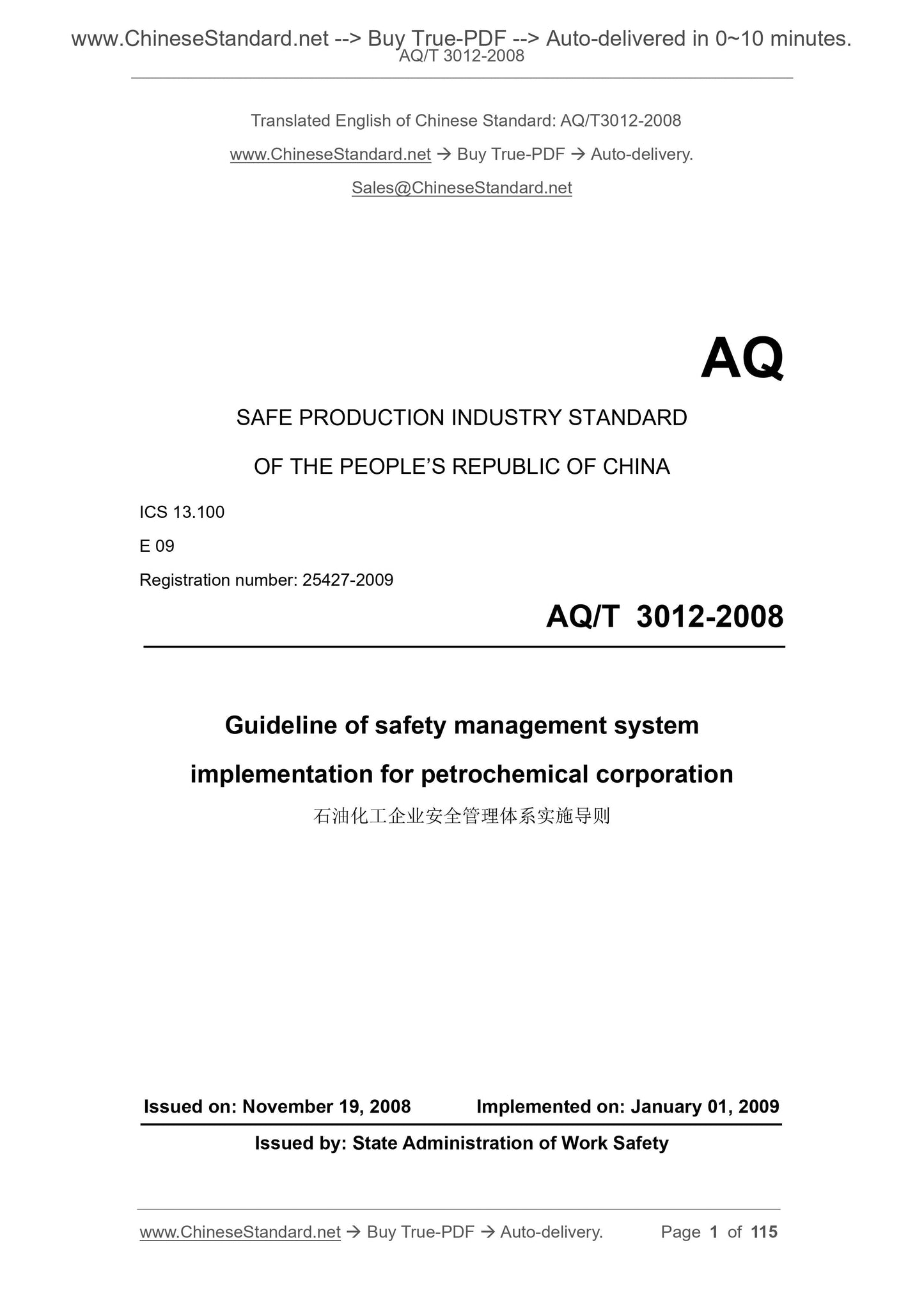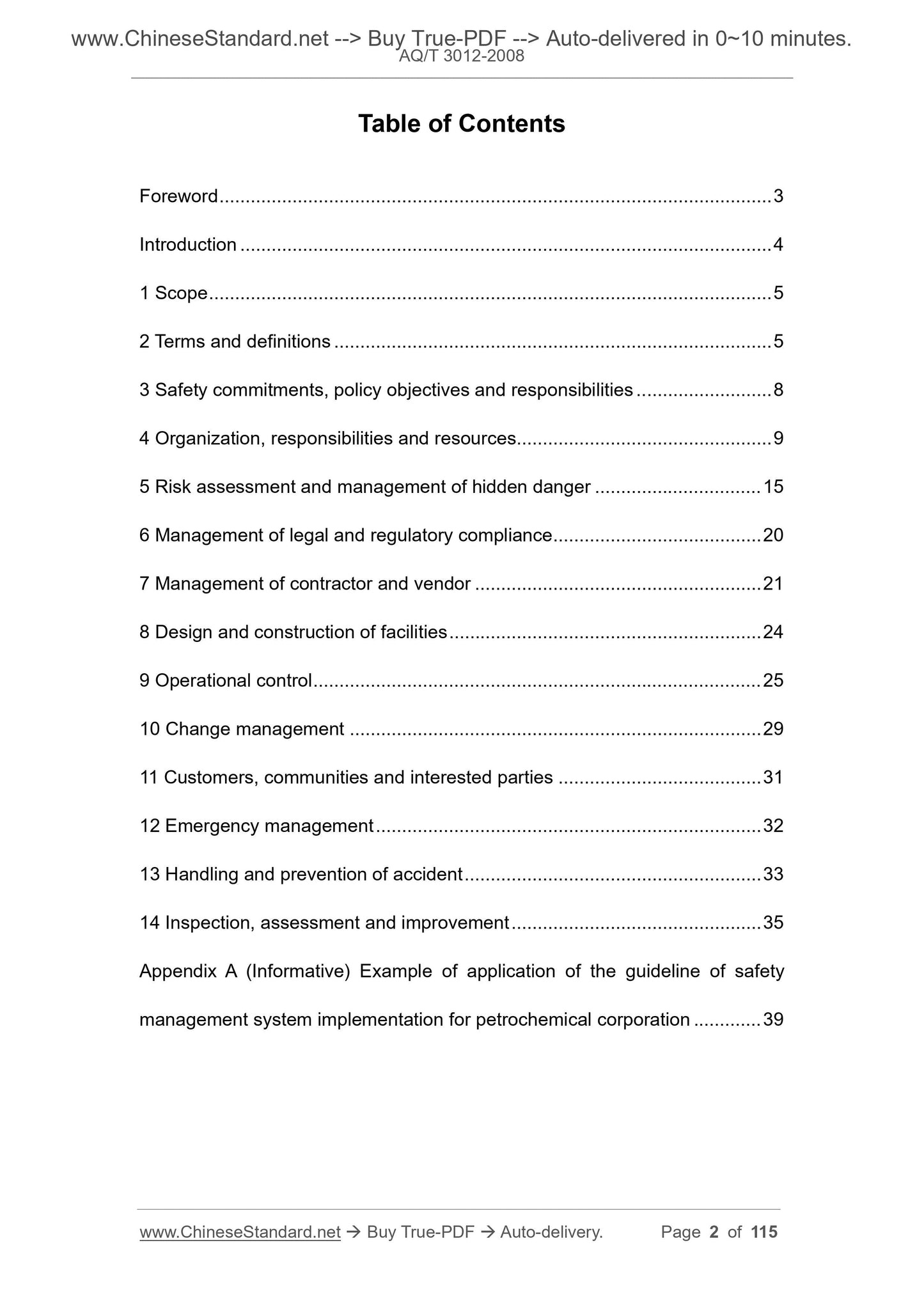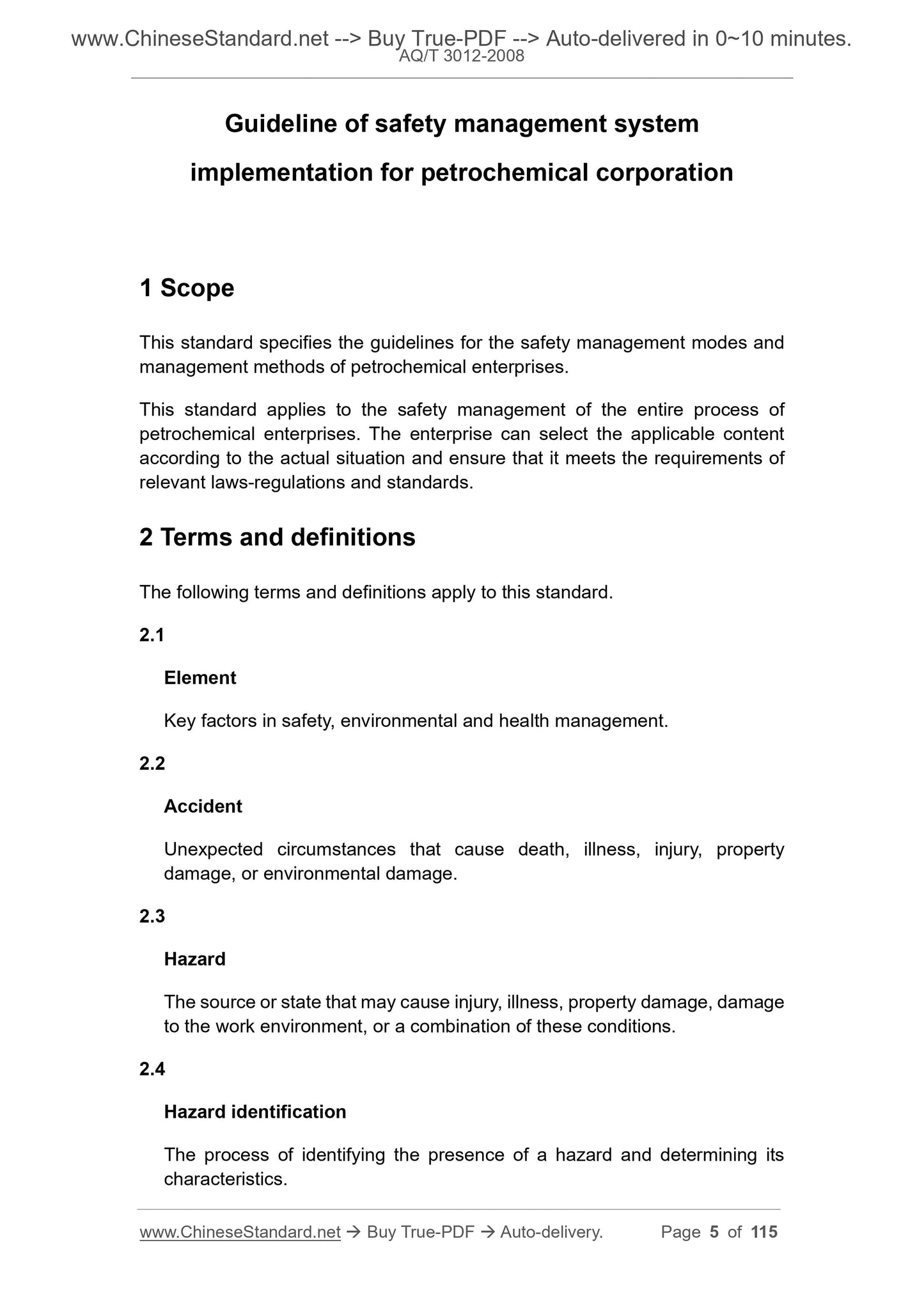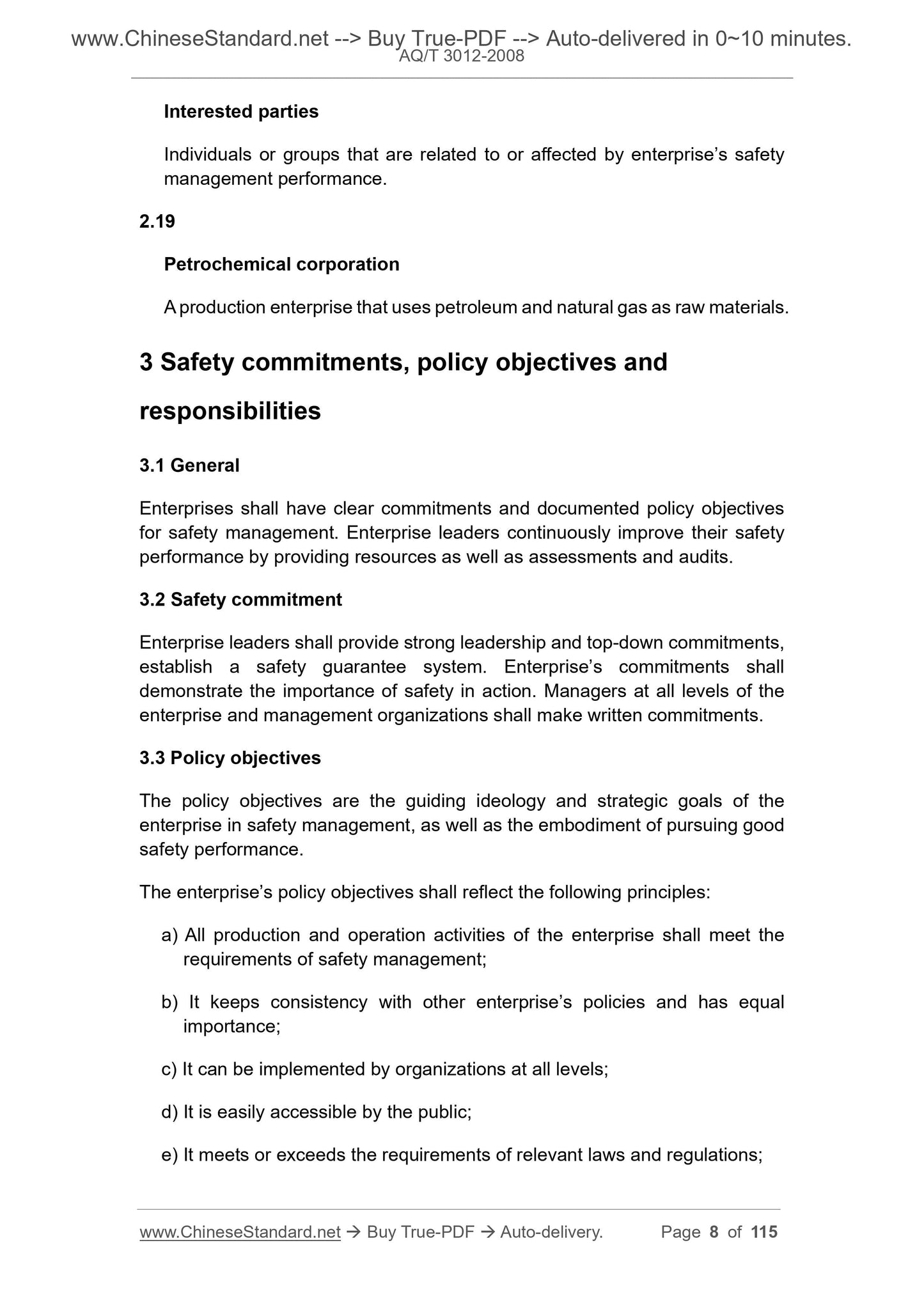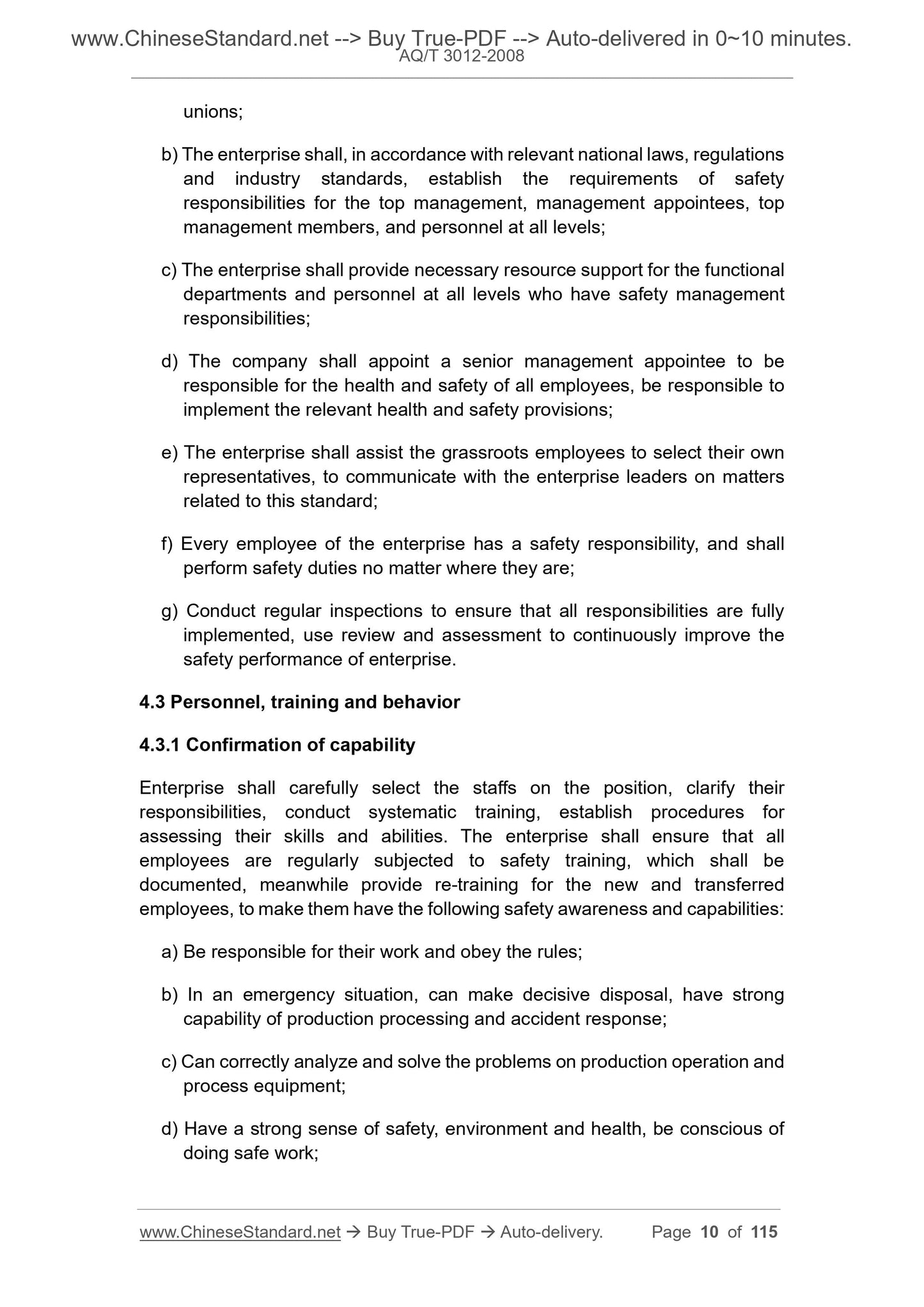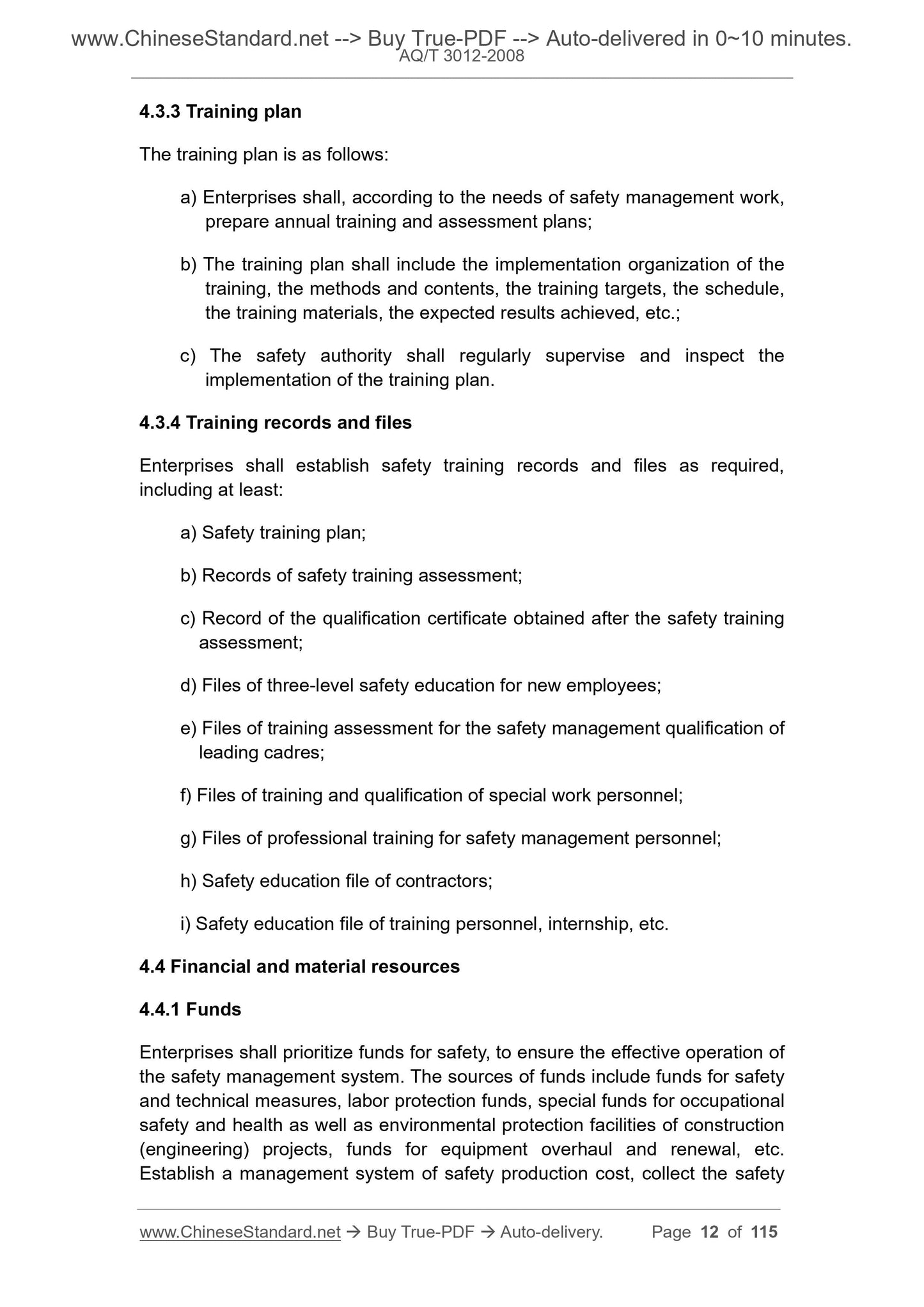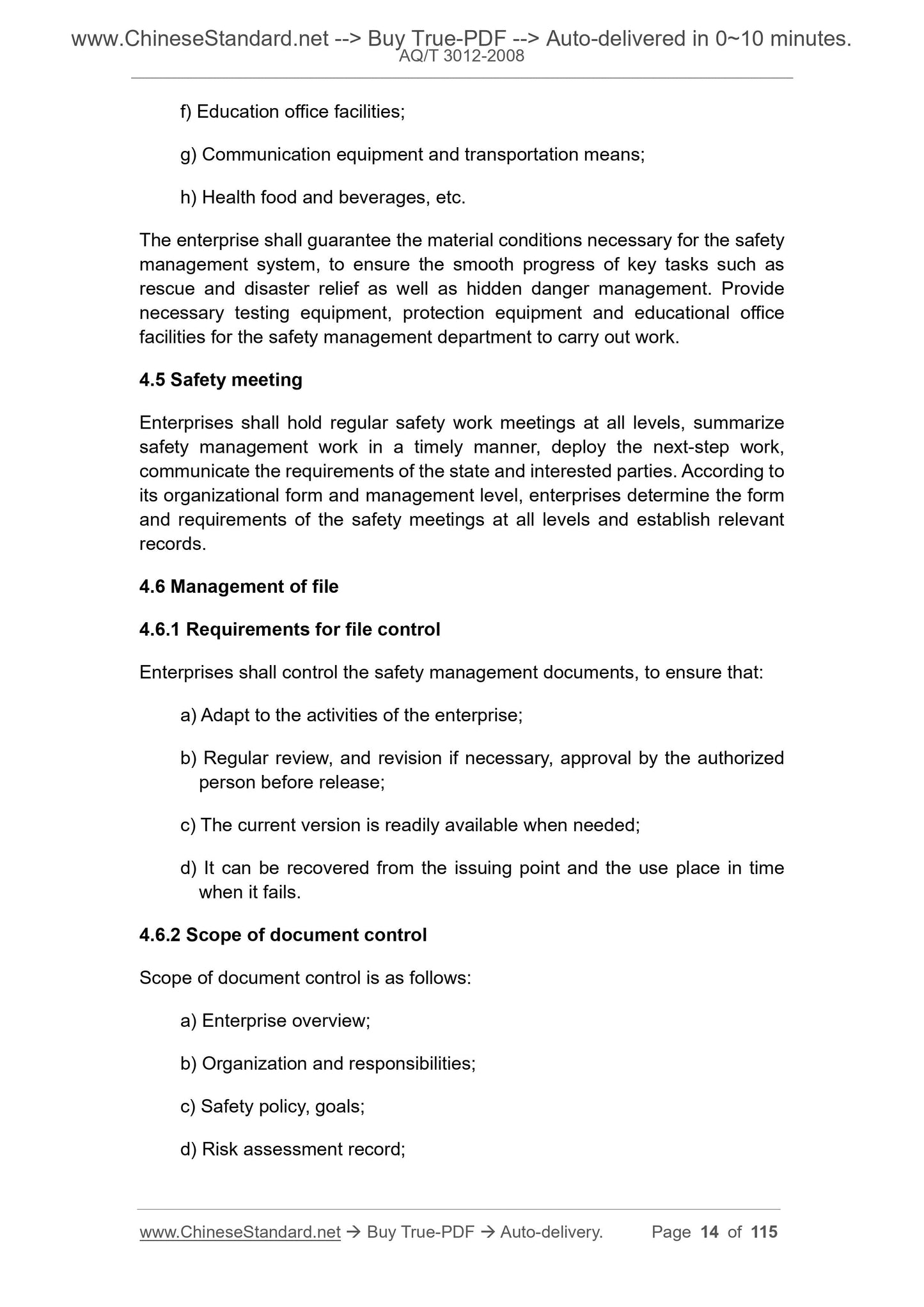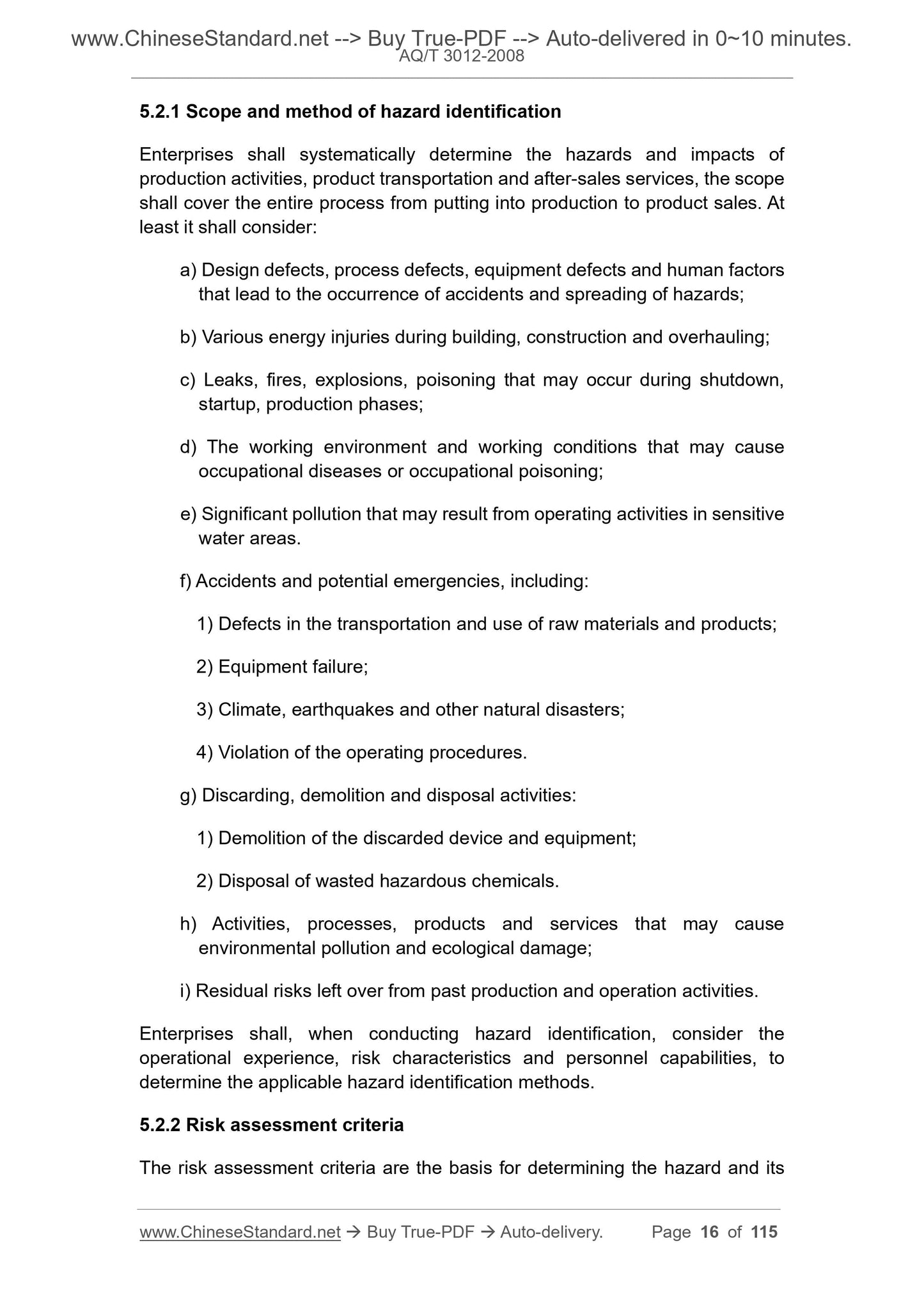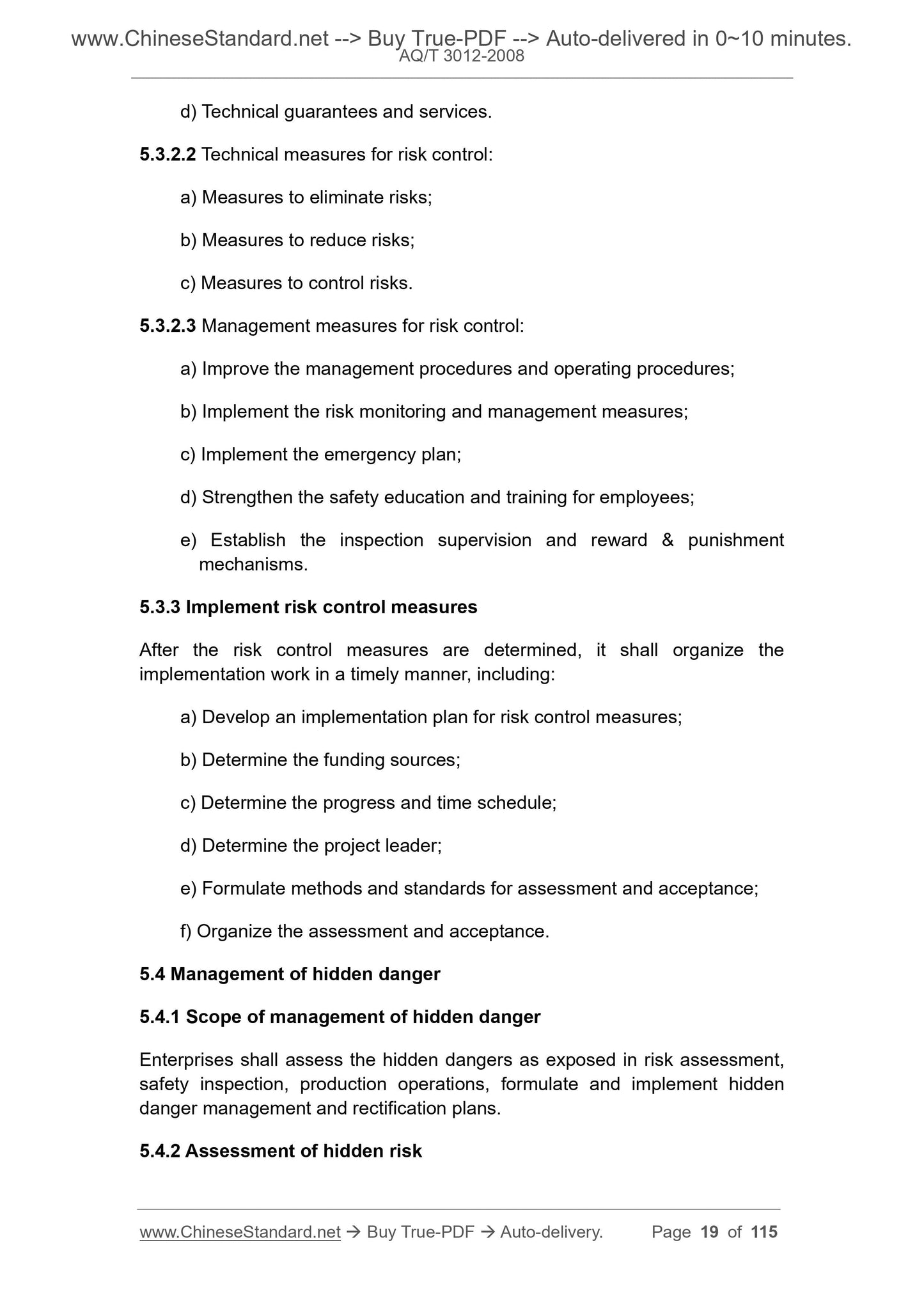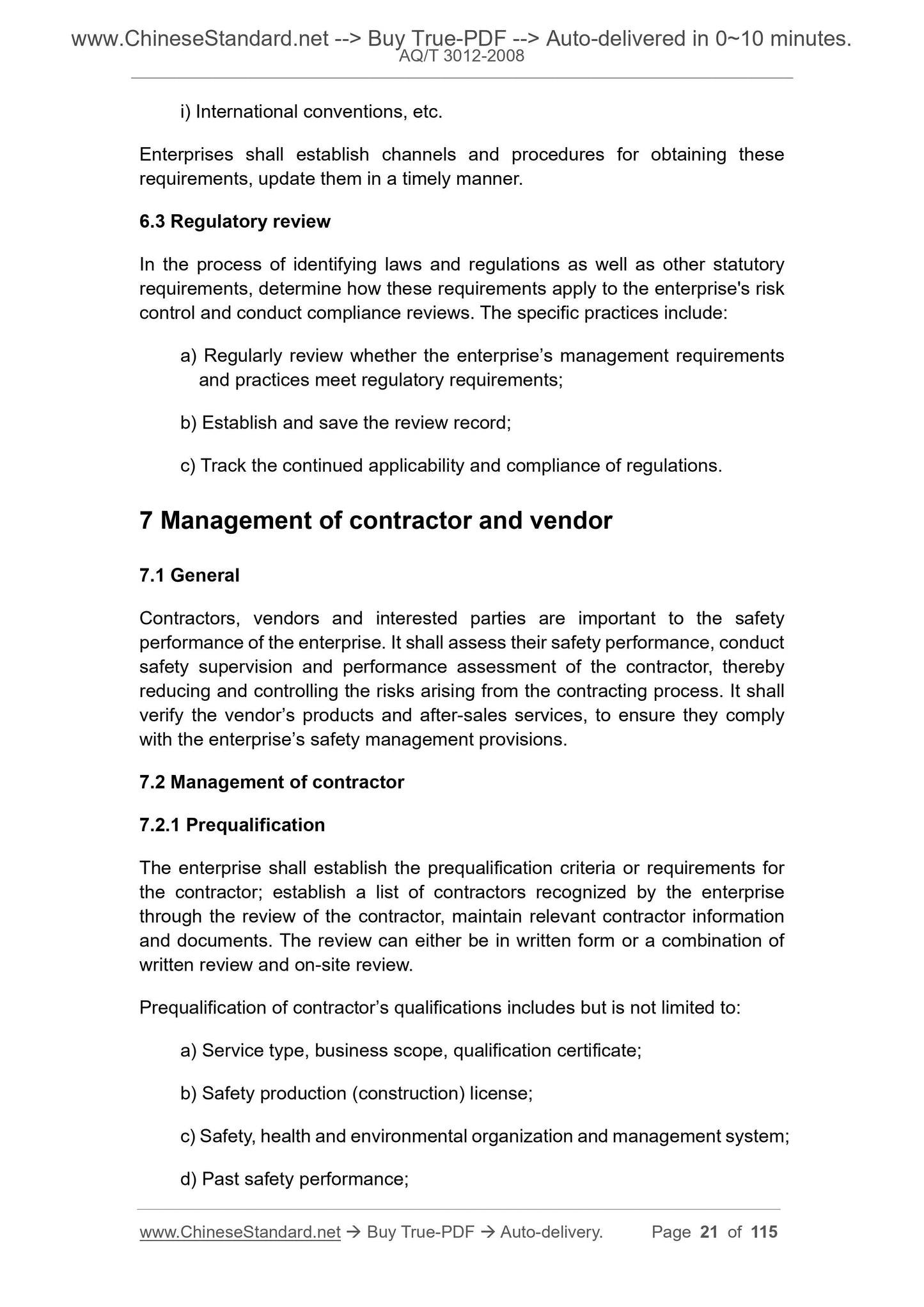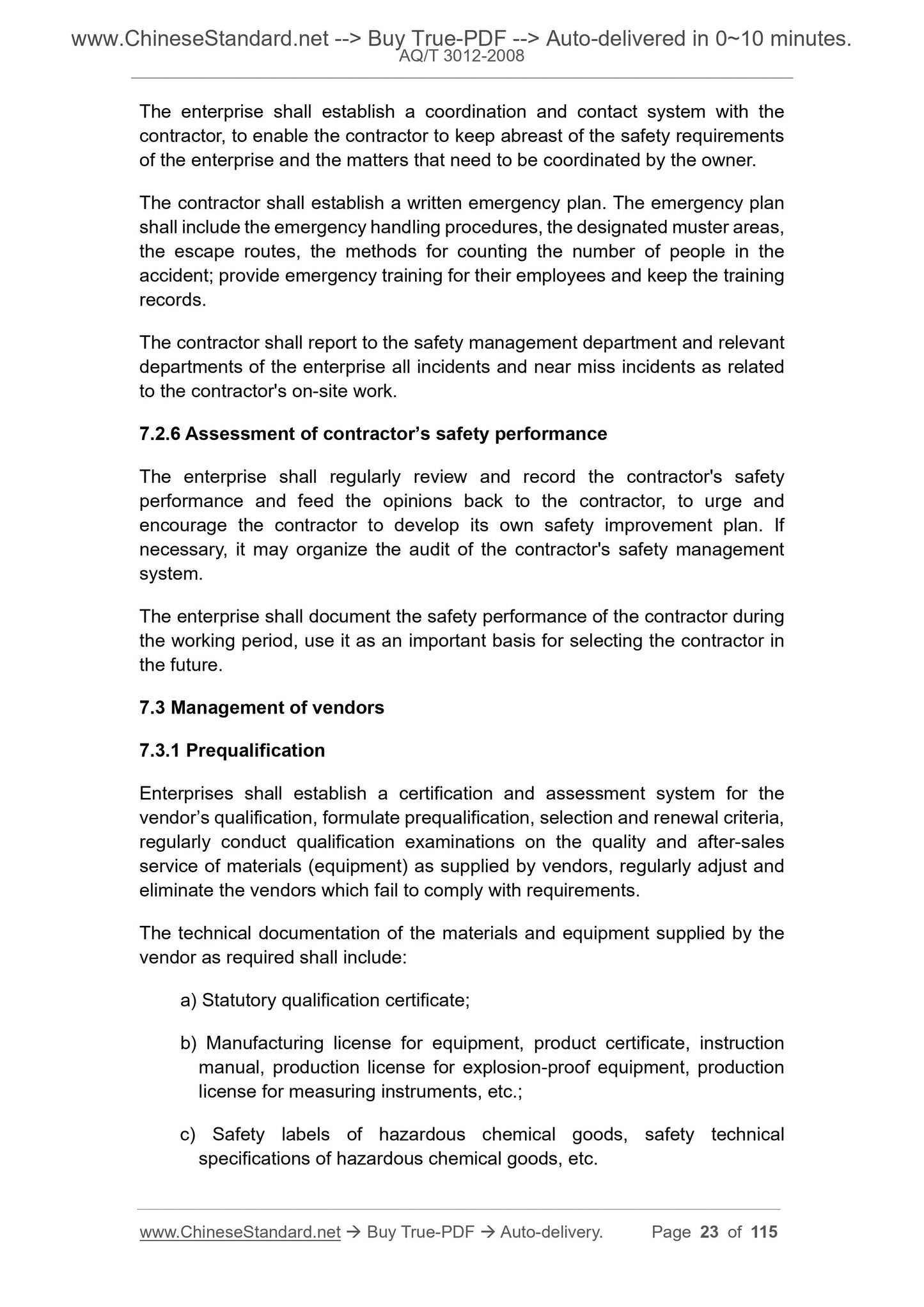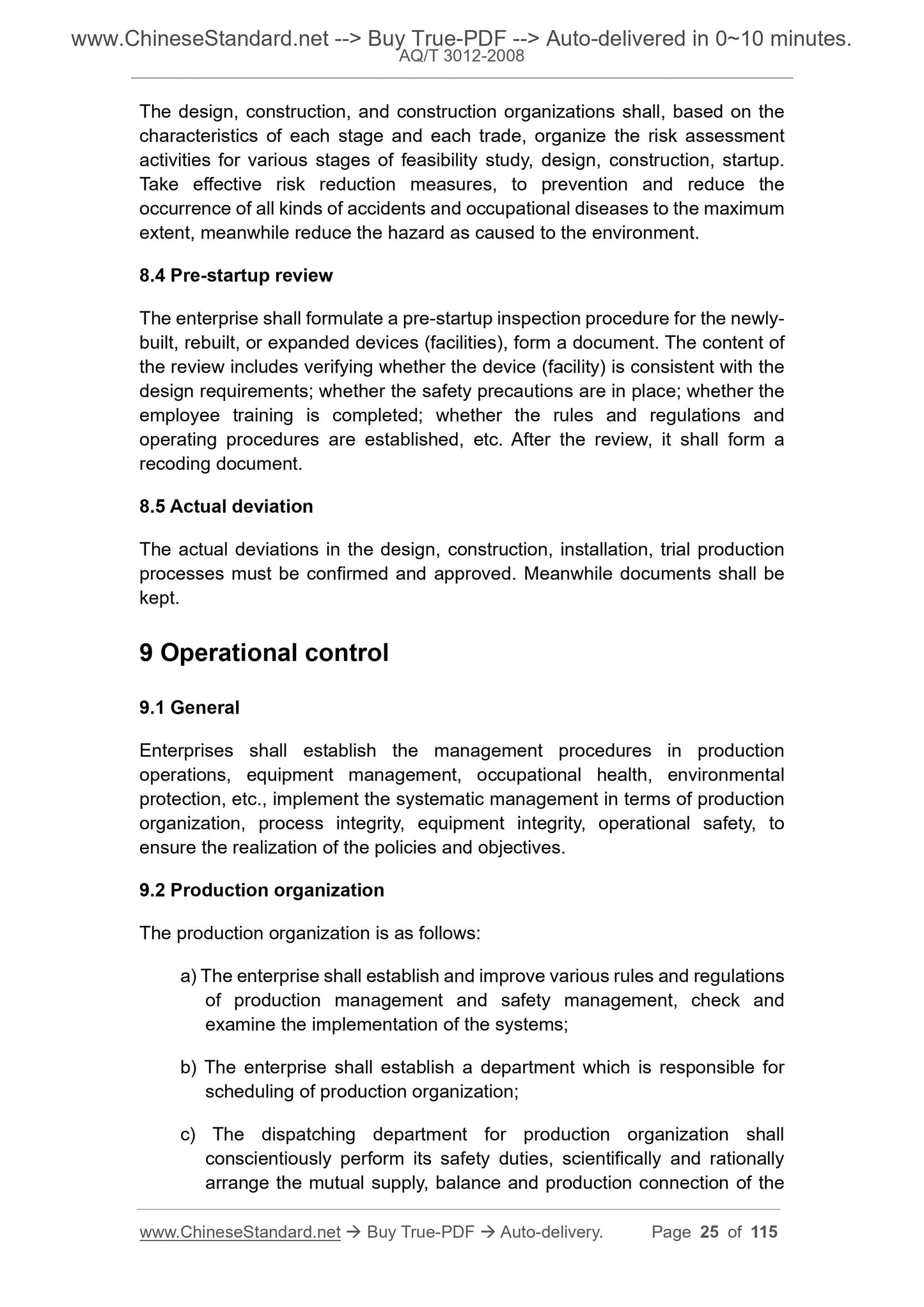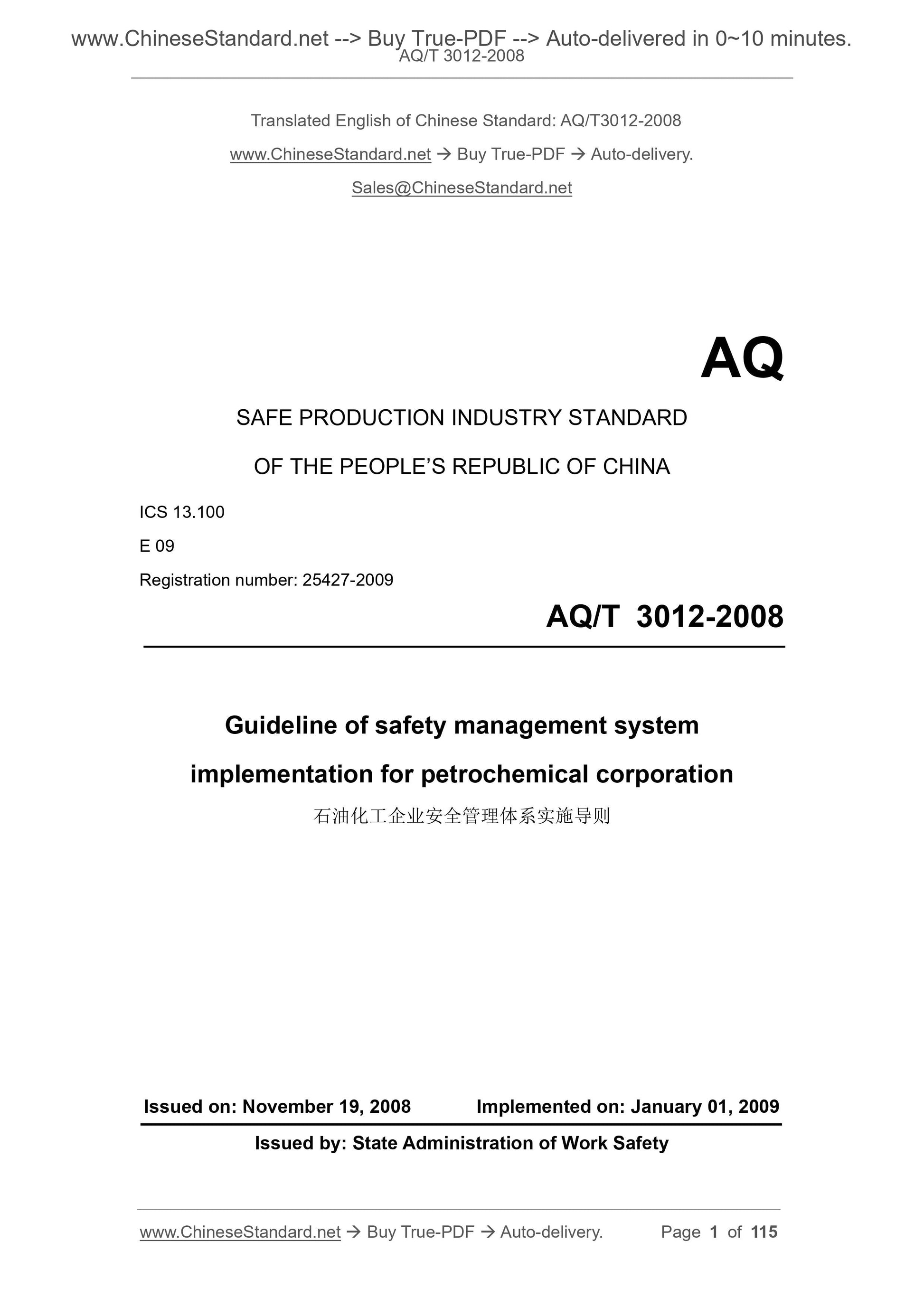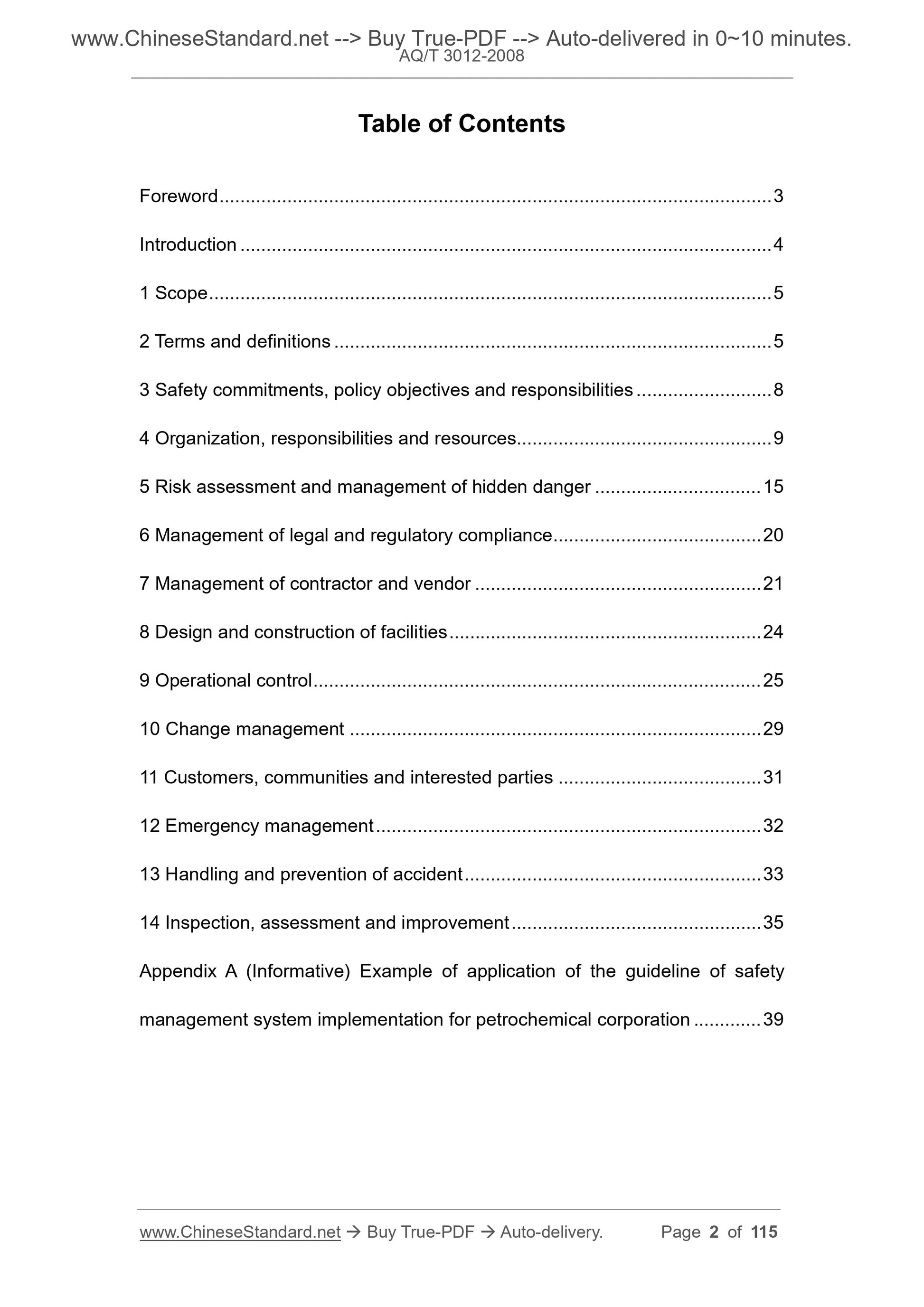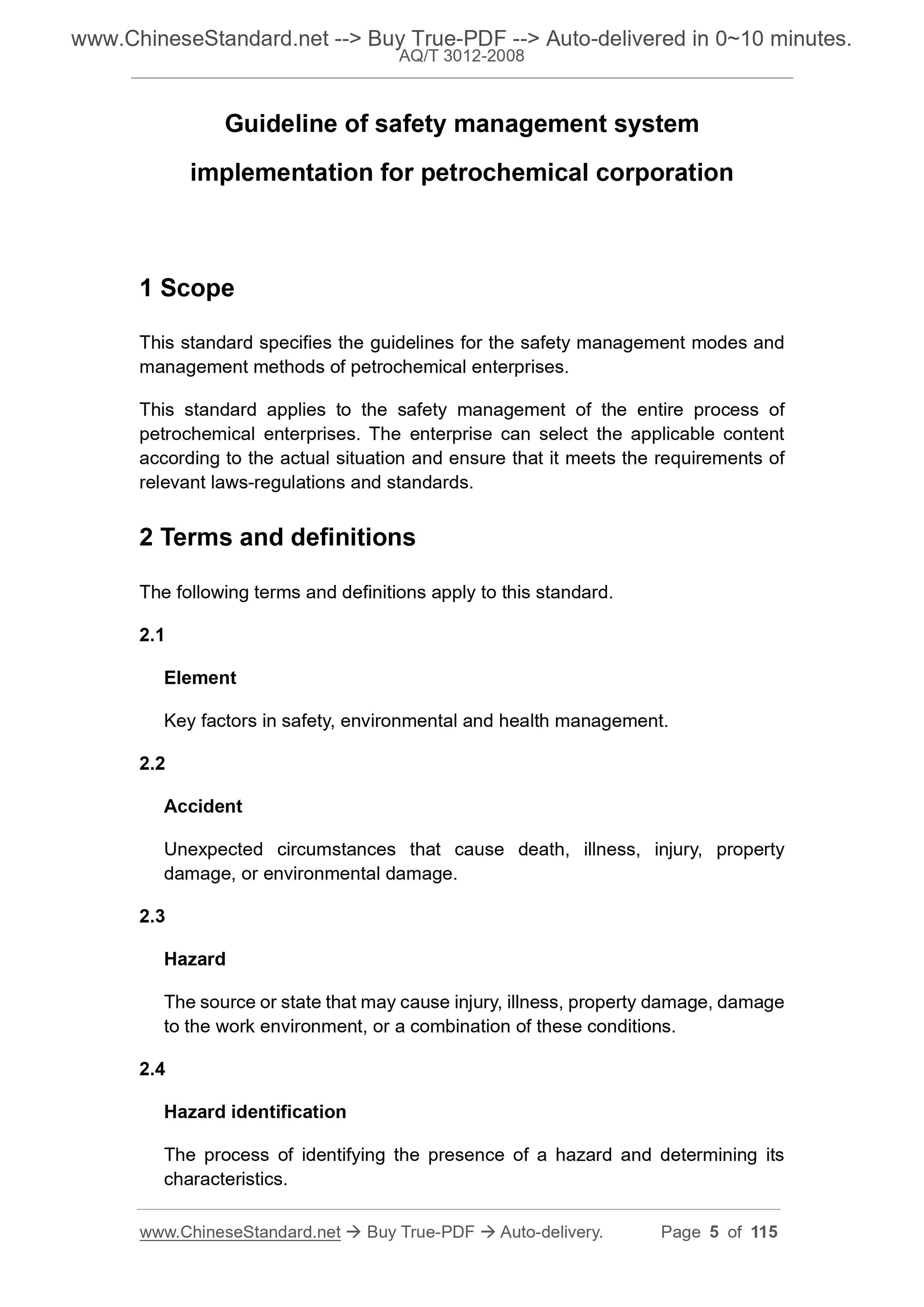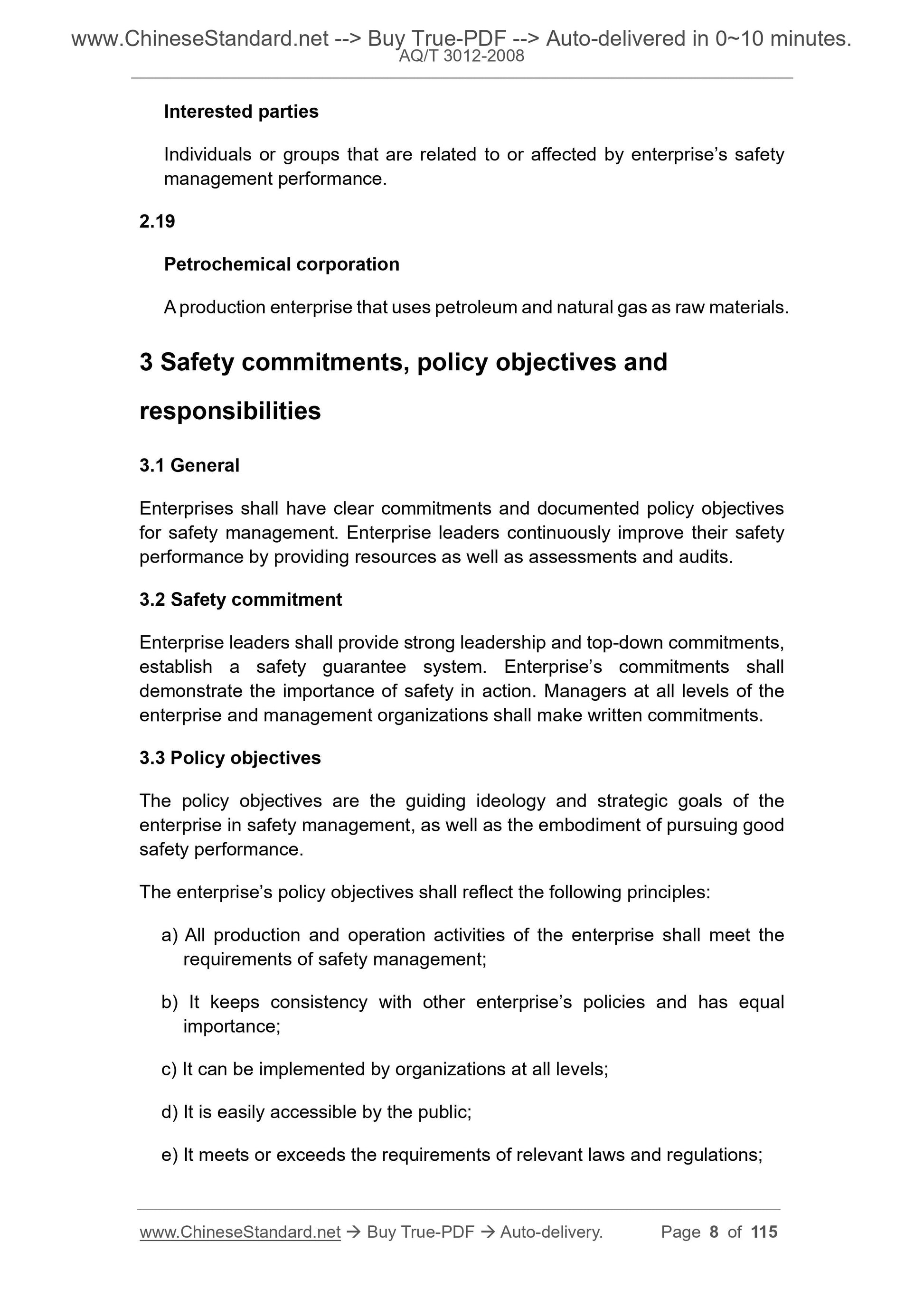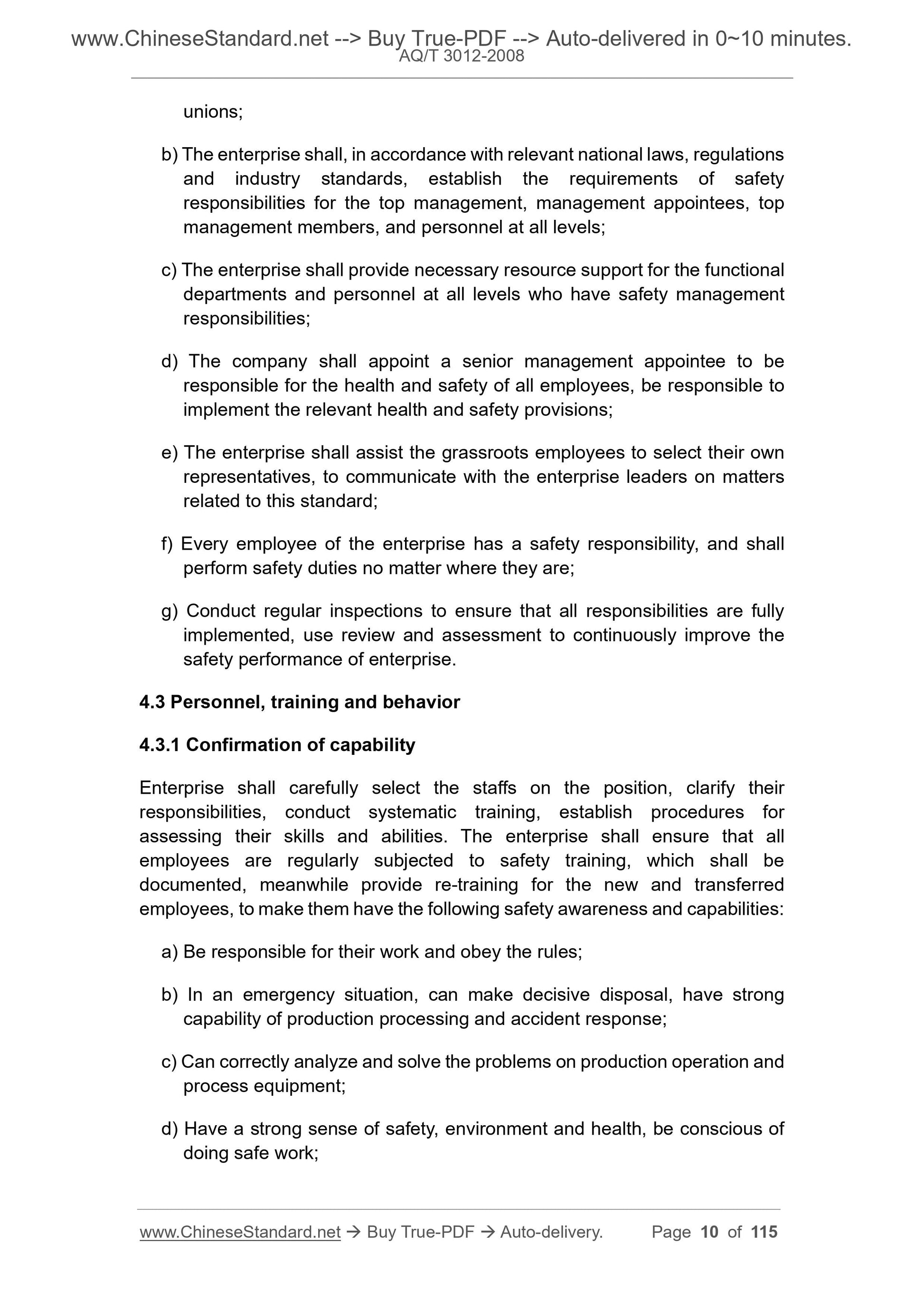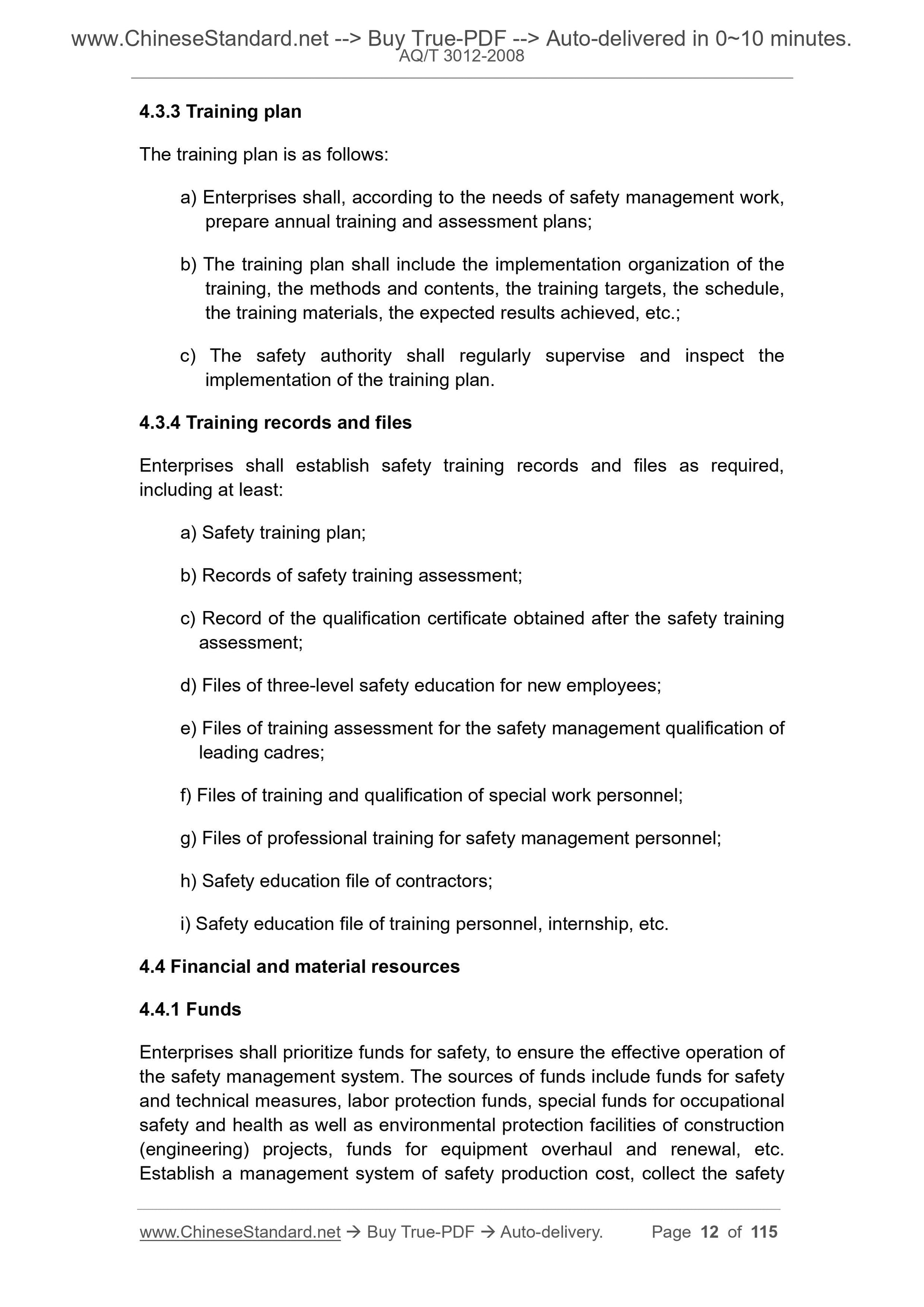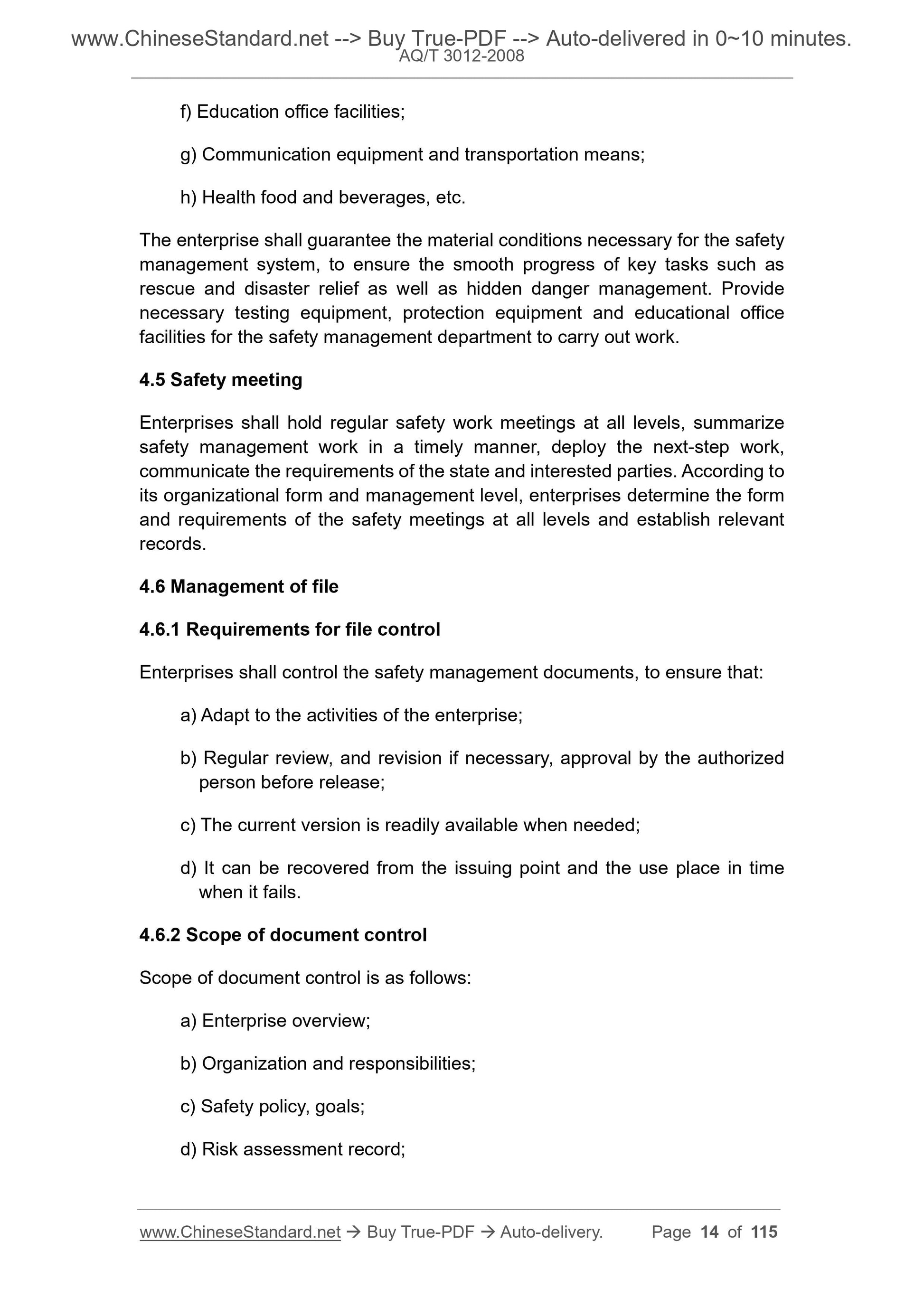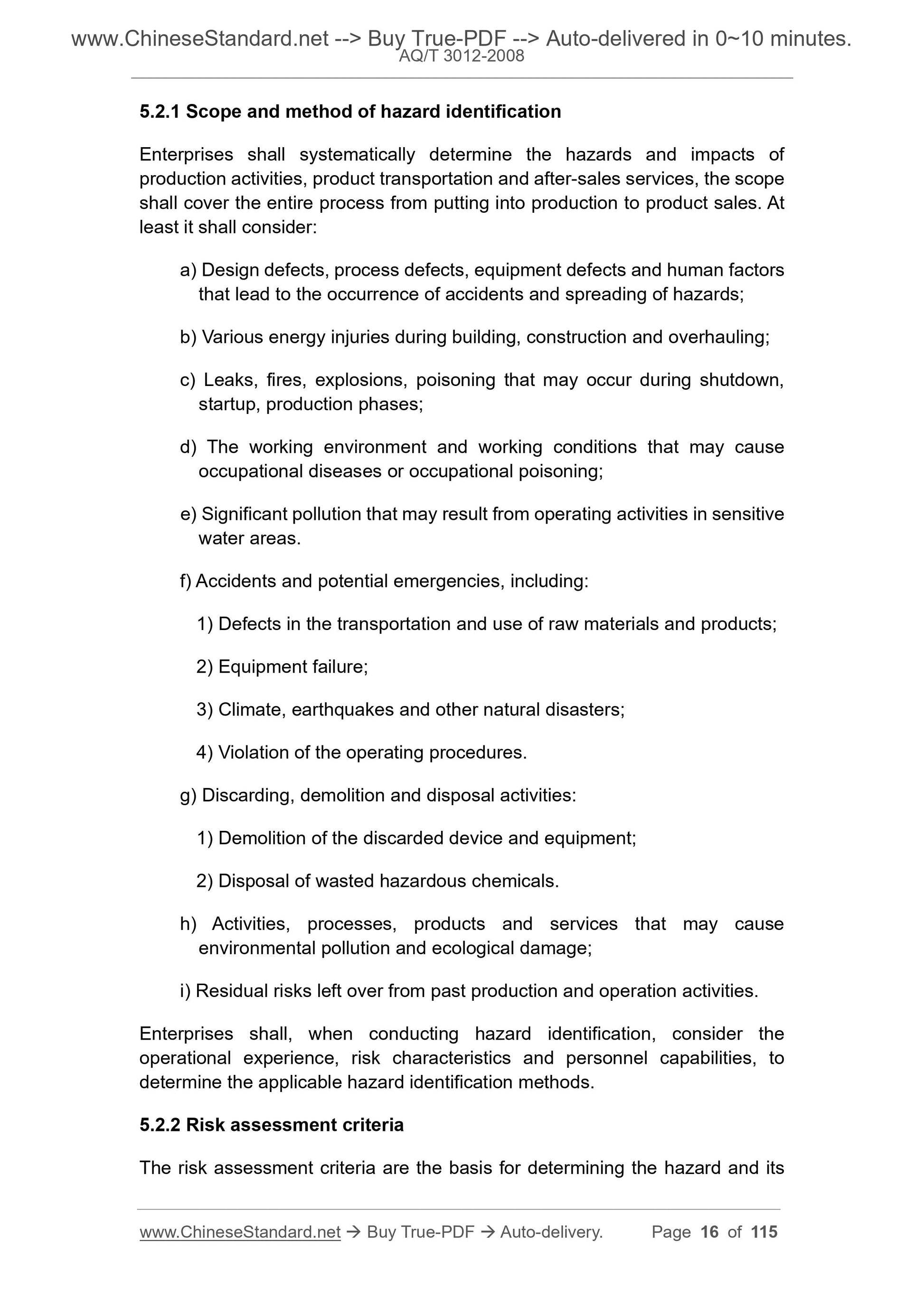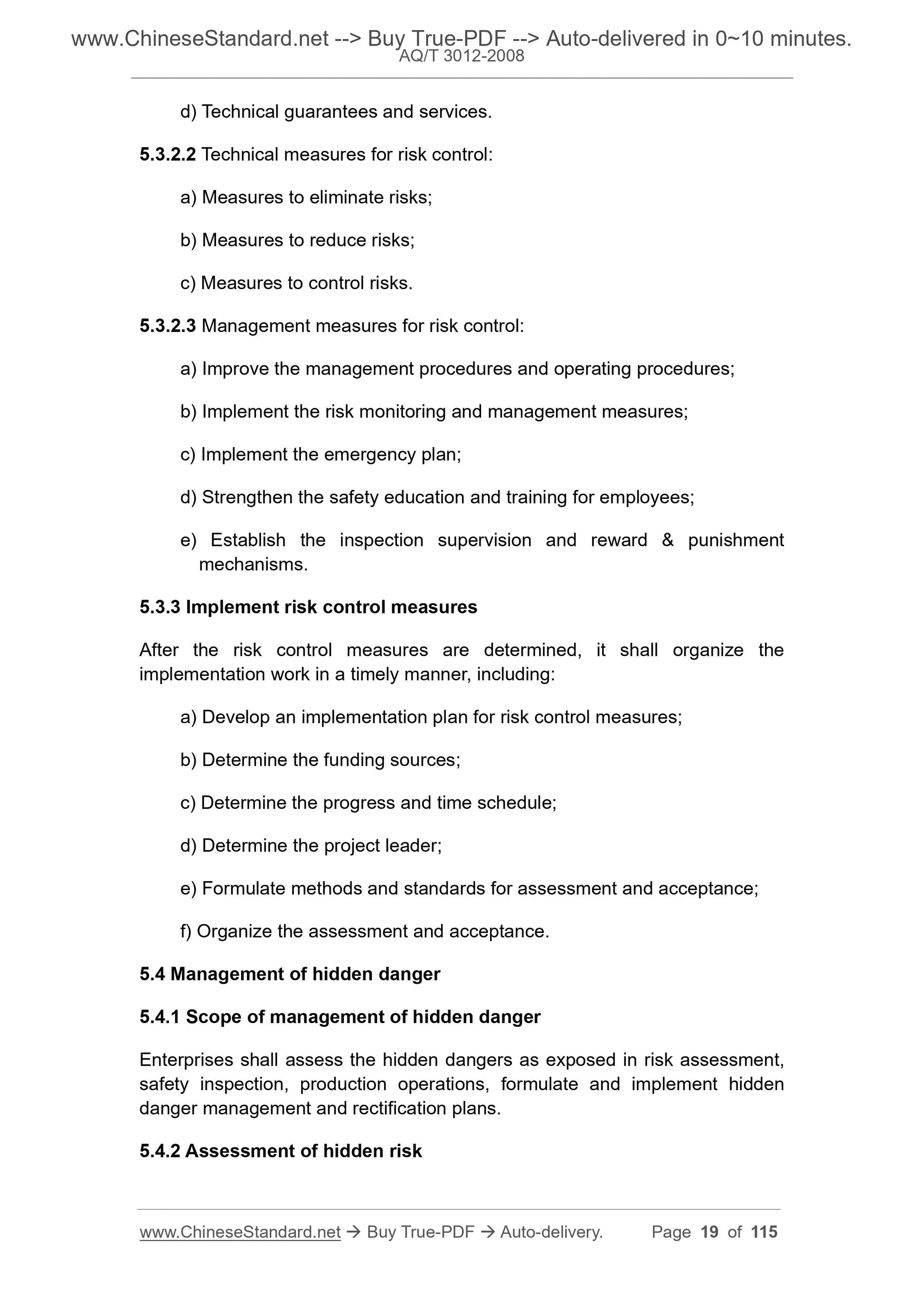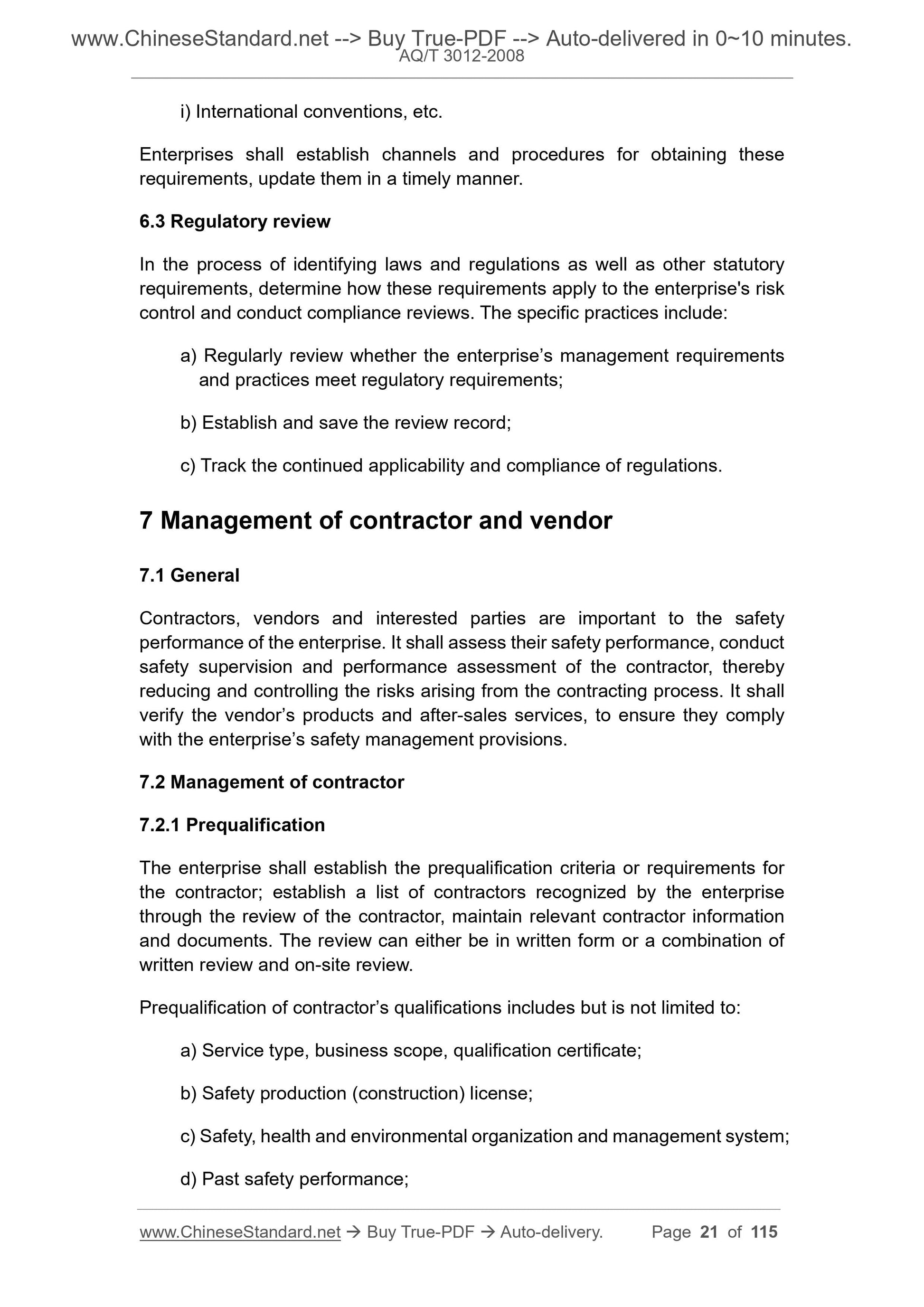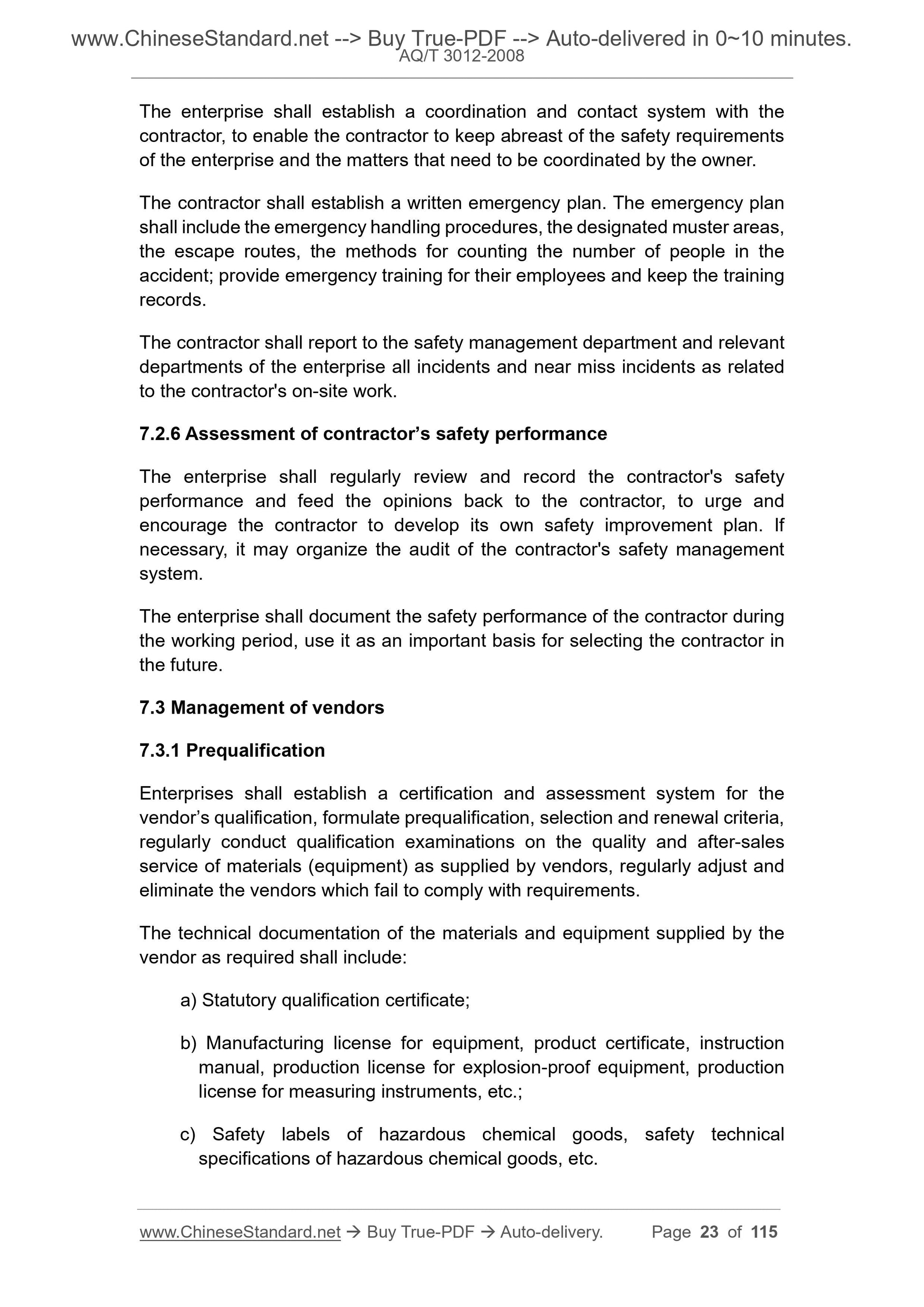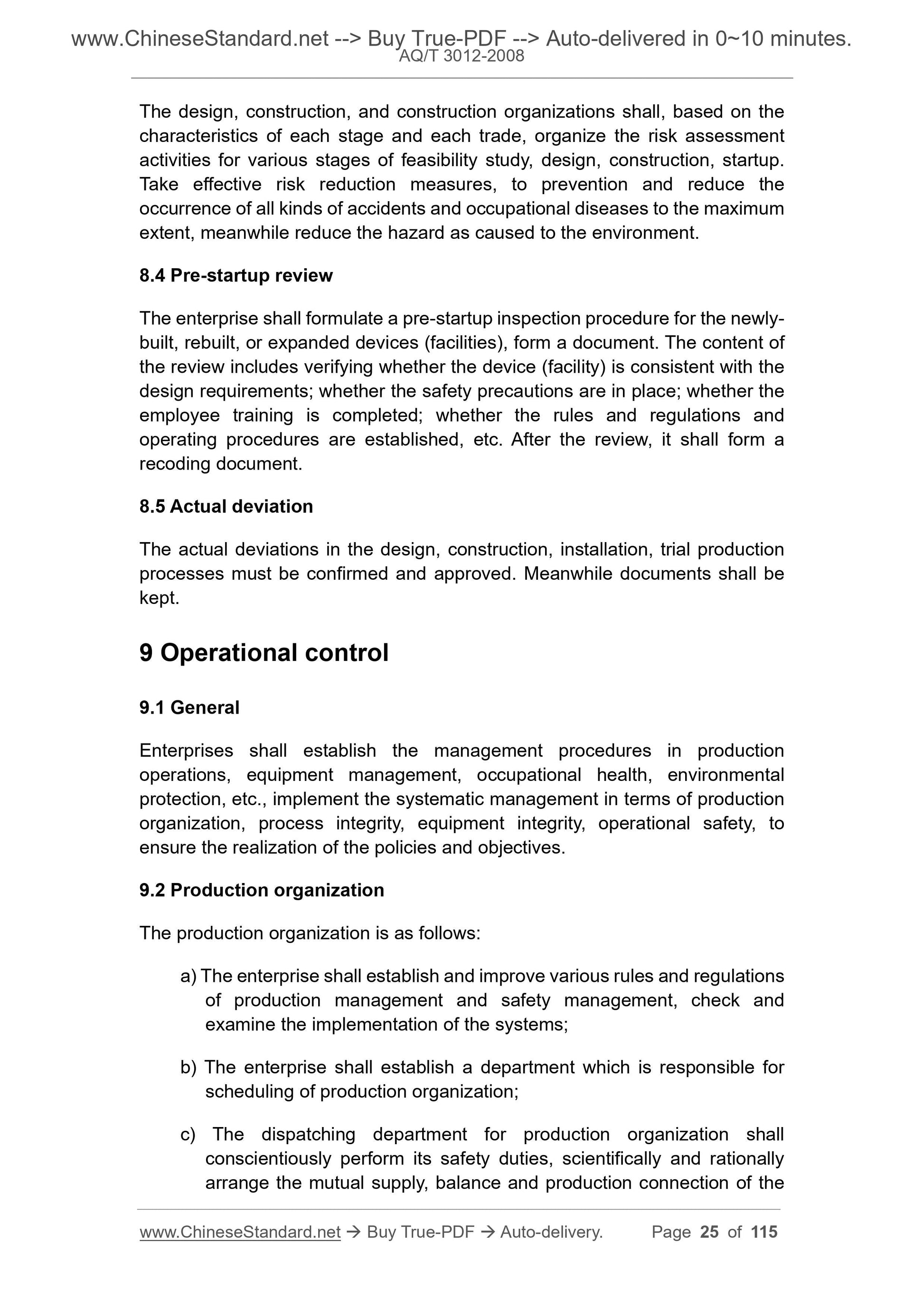1
/
of
12
PayPal, credit cards. Download editable-PDF & invoice In 1 second!
AQ/T 3012-2008 English PDF (AQ/T3012-2008)
AQ/T 3012-2008 English PDF (AQ/T3012-2008)
Regular price
$490.00 USD
Regular price
Sale price
$490.00 USD
Unit price
/
per
Shipping calculated at checkout.
Couldn't load pickup availability
Delivery: 3 seconds. Download true-PDF + Invoice.
Get Quotation: Click AQ/T 3012-2008 (Self-service in 1-minute)
Historical versions (Master-website): AQ/T 3012-2008
Preview True-PDF (Reload/Scroll-down if blank)
AQ/T 3012-2008: Guideline of safety management system implementation for petrochemical corporation
AQ/T 3012-2008
AQ
SAFE PRODUCTION INDUSTRY STANDARD
OF THE PEOPLE’S REPUBLIC OF CHINA
ICS 13.100
E 09
Registration number. 25427-2009
Guideline of safety management system
implementation for petrochemical corporation
ISSUED ON. NOVEMBER 19, 2008
IMPLEMENTED ON. JANUARY 01, 2009
Issued by. State Administration of Work Safety
Table of Contents
Foreword ... 3
Introduction ... 4
1 Scope ... 5
2 Terms and definitions ... 5
3 Safety commitments, policy objectives and responsibilities ... 8
4 Organization, responsibilities and resources... 9
5 Risk assessment and management of hidden danger ... 15
6 Management of legal and regulatory compliance ... 20
7 Management of contractor and vendor ... 21
8 Design and construction of facilities ... 24
9 Operational control ... 25
10 Change management ... 29
11 Customers, communities and interested parties ... 31
12 Emergency management ... 32
13 Handling and prevention of accident ... 33
14 Inspection, assessment and improvement ... 35
Appendix A (Informative) Example of application of the guideline of safety
management system implementation for petrochemical corporation ... 39
Guideline of safety management system
implementation for petrochemical corporation
1 Scope
This standard specifies the guidelines for the safety management modes and
management methods of petrochemical enterprises.
This standard applies to the safety management of the entire process of
petrochemical enterprises. The enterprise can select the applicable content
according to the actual situation and ensure that it meets the requirements of
relevant laws-regulations and standards.
2 Terms and definitions
The following terms and definitions apply to this standard.
2.1
Element
Key factors in safety, environmental and health management.
2.2
Accident
Unexpected circumstances that cause death, illness, injury, property
damage, or environmental damage.
2.3
Hazard
The source or state that may cause injury, illness, property damage, damage
to the work environment, or a combination of these conditions.
2.4
Hazard identification
The process of identifying the presence of a hazard and determining its
characteristics.
Interested parties
Individuals or groups that are related to or affected by enterprise’s safety
management performance.
2.19
Petrochemical corporation
A production enterprise that uses petroleum and natural gas as raw materials.
3 Safety commitments, policy objectives and
responsibilities
3.1 General
Enterprises shall have clear commitments and documented policy objectives
for safety management. Enterprise leaders continuously improve their safety
performance by providing resources as well as assessments and audits.
3.2 Safety commitment
Enterprise leaders shall provide strong leadership and top-down commitments,
establish a safety guarantee system. Enterprise’s commitments shall
demonstrate the importance of safety in action. Managers at all levels of the
enterprise and management organizations shall make written commitments.
3.3 Policy objectives
The policy objectives are the guiding ideology and strategic goals of the
enterprise in safety management, as well as the embodiment of pursuing good
safety performance.
The enterprise’s policy objectives shall reflect the following principles.
a) All production and operation activities of the enterprise shall meet the
requirements of safety management;
b) It keeps consistency with other enterprise’s policies and has equal
importance;
c) It can be implemented by organizations at all levels;
d) It is easily accessible by the public;
e) It meets or exceeds the requirements of relevant laws and regulations;
unions;
b) The enterprise shall, in accordance with relevant national laws, regulations
and industry standards, establish the requirements of safety
responsibilities for the top management, management appointees, top
management members, and personnel at all levels;
c) The enterprise shall provide necessary resource support for the functional
departments and personnel at all levels who have safety management
responsibilities;
d) The company shall appoint a senior management appointee to be
responsible for the health and safety of all employees, be responsible to
implement the relevant health and safety provisions;
e) The enterprise shall assist the grassroots employees to select their own
representatives, to communicate with the enterprise leaders on matters
related to this standard;
f) Every employee of the enterprise has a safety responsibility, and shall
perform safety duties no matter where they are;
g) Conduct regular inspections to ensure that all responsibilities are fully
implemented, use review and assessment to continuously improve the
safety performance of enterprise.
4.3 Personnel, training and behavior
4.3.1 Confirmation of capability
Enterprise shall carefully select the staffs on the position, clarify their
responsibilities, conduct systematic training, establish procedures for
assessing their skills and abilities. The enterprise shall ensure that all
employees are regularly subjected to safety training, which shall be
documented, meanwhile provide re-training for the new and transferred
employees, to make them have the following safety awareness and capabilities.
a) Be responsible for their work and obey the rules;
b) In an emergency situation, can make decisive disposal, have strong
capability of production processing and accident response;
c) Can correctly analyze and solve the problems on production operation and
process equipment;
d) Have a strong sense of safety, environment and health, be conscious of
doing safe work;
4.3.3 Training plan
The training plan is as follows.
a) Enterprises shall, according to the needs of safety management work,
prepare annual training and assessment plans;
b) The training plan shall include the implementation organization of the
training, the methods and contents, the training targets, the schedule,
the training materials, the expected results achieved, etc.;
c) The safety authority shall regularly supervise and inspect the
implementation of the training plan.
4.3.4 Training records and files
Enterprises shall establish safety training records and files as required,
including at least.
a) Safety training plan;
b) Records of safety training assessment;
c) Record of the qualification certificate obtained after the safety training
assessment;
d) Files of three-level safety education for new employees;
e) Files of training assessment for the safety management qualification of
leading cadres;
f) Files of training and qualification of special work personnel;
g) Files of professional training for safety management personnel;
h) Safety education file of contractors;
i) Safety education file of training personnel, internship, etc.
4.4 Financial and material resources
4.4.1 Funds
Enterprises shall prioritize funds for safety, to ensure the effective operation of
the safety management system. The sources of funds include funds for safety
and technical measures, labor protection funds, special funds for occupational
safety and health as well as environmental protection facilities of construction
(engineering) projects, funds for equipment overhaul and renewal, etc.
Establish a management system of safety production cost, collect the safety
f) Education office facilities;
g) Communication equipment and transportation means;
h) Health food and beverages, etc.
The enterprise shall guarantee the material conditions necessary for the safety
management system, to ensure the smooth progress of key tasks such as
rescue and disaster relief as well as hidden danger management. Provide
necessary testing equipment, protection equipment and educational office
facilities for the safety management department to carry out work.
4.5 Safety meeting
Enterprises shall hold regular safety work meetings at all levels, summarize
safety management work in a timely manner, deploy the next-step work,
communicate the requirements of the state and interested parties. According to
its organizational form and management level, enterprises determine the form
and requirements of the safety meetings at all levels and establish relevant
records.
4.6 Management of file
4.6.1 Requirements for file control
Enterprises shall control the safety management documents, to ensure that.
a) Adapt to the activities of the enterprise;
b) Regular review, and revision if necessary, approval by the authorized
person before release;
c) The current version is readily available when needed;
d) It can be recovered from the issuing point and the use place in time
when it fails.
4.6.2 Scope of document control
Scope of document control is as follows.
a) Enterprise overview;
b) Organization and responsibilities;
c) Safety policy, goals;
d) Risk assessment record;
5.2.1 Scope and method of hazard identification
Enterprises shall systematically determine the hazards and impacts of
production activities, product transportation and after-sales services, the scope
shall cover the entire process from putting into production to product sales. At
least it shall consider.
a) Design defects, process defects, equipment defects and human factors
that lead to the occurrence of accidents and spreading of hazards;
b) Various energy injuries during building, construction and overhauling;
c) Leaks, fires, explosions, poisoning that may occur during shutdown,
startup, production phases;
d) The working environment and working conditions that may cause
occupational diseases or occupational poisoning;
e) Significant pollution that may result from operating activities in sensitive
water areas.
f) Accidents and potential emergencies, including.
1) Defects in the transportation and use of raw materials and products;
2) Equipment failure;
3) Climate, earthquakes and other natural disasters;
4) Violation of the operating procedures.
g) Discarding, demolition and disposal activities.
1) Demolition of the discarded device and equipment;
2) Disposal of wasted hazardous chemicals.
h) Activities, processes, products and services that may cause
environmental pollution and ecological damage;
i) Residual risks left over from past production and operation activities.
Enterprises shall, when conducting hazard identification, consider the
operational experience, risk characteristics and personnel capabilities, to
determine the applicable hazard identification methods.
5.2.2 Risk assessment criteria
The risk assessment criteria are the basis for determining the hazard and its
d) Technical guarantees and services.
5.3.2.2 Technical measures for risk control.
a) Measures to eliminate risks;
b) Measures to reduce risks;
c) Measures to control risks.
5.3.2.3 Management measures for risk control.
a) Improve the management procedures and operating procedures;
b) Implement the risk monitoring and management measures;
c) Implement the emergency plan;
d) Strengthen the safety education and training for employees;
e) Establish the inspection supervision and reward and punishment
mechanisms.
5.3.3 Implement risk control measures
After the risk control measures are determined, it shall organize the
implementation work in a timely manner, including.
a) Develop an implementation plan for risk control measures;
b) Determine the funding sources;
c) Determine the progress and time schedule;
d) Determine the project leader;
e) Formulate methods and standards for assessment and acceptance;
f) Organize the assessment and acceptance.
5.4 Management of hidden danger
5.4.1 Scope of management of hidden danger
Enterprises shall assess the hidden dangers as exposed in risk assessment,
safety inspection, production operations, formulate and implement hidden
danger management and rectification plans.
5.4.2 Assessment of hidden risk
i) International conventions, etc.
Enterprises shall establish channels and procedures for obtaining these
requirements, update them in a timely manner.
6.3 Regulatory review
In the process of identifying laws and regulations as well as other statutory
requirements, determine how these requirements apply to the enterprise's risk
control and conduct compliance reviews. The specific practices include.
a) Regularly review whether the enterprise’s management requirements
and practices meet regulatory requirements;
b) Establish and save the review record;
c) Track the continued applicability and compliance of regulations.
7 Management of contractor and vendor
7.1 General
Contractors, vendors and interested parties are important to the safety
performance of the enterprise. It shall assess their safety performance, conduct
safety supervision and performance assessment of the contractor, thereby
reducing and controlling the risks arising from the contracting process. It shall
verify the vendor’s products and after-sales services, to ensure they comply
with the enterprise’s safety management provisions.
7.2 Management of contractor
7.2.1 Prequalification
The enterprise shall establish the prequalification criteria or requirements for
the contractor; establish a list of contractors recognized by the enterprise
through the review of the contractor, maintain relevant contractor information
and documents. The review can either be in written form or a combination of
written review and on-site review.
Prequalification of contractor’s qualifications includes but is not limited to.
a) Service type, business scope, qualification certificate;
b) Safety production (construction) license;
c) Safety, health and environmental organization and management system;
d) Past safety performance;
The enterprise shall establish a coordination and contact system with the
contractor, to enable the contractor t...
Get Quotation: Click AQ/T 3012-2008 (Self-service in 1-minute)
Historical versions (Master-website): AQ/T 3012-2008
Preview True-PDF (Reload/Scroll-down if blank)
AQ/T 3012-2008: Guideline of safety management system implementation for petrochemical corporation
AQ/T 3012-2008
AQ
SAFE PRODUCTION INDUSTRY STANDARD
OF THE PEOPLE’S REPUBLIC OF CHINA
ICS 13.100
E 09
Registration number. 25427-2009
Guideline of safety management system
implementation for petrochemical corporation
ISSUED ON. NOVEMBER 19, 2008
IMPLEMENTED ON. JANUARY 01, 2009
Issued by. State Administration of Work Safety
Table of Contents
Foreword ... 3
Introduction ... 4
1 Scope ... 5
2 Terms and definitions ... 5
3 Safety commitments, policy objectives and responsibilities ... 8
4 Organization, responsibilities and resources... 9
5 Risk assessment and management of hidden danger ... 15
6 Management of legal and regulatory compliance ... 20
7 Management of contractor and vendor ... 21
8 Design and construction of facilities ... 24
9 Operational control ... 25
10 Change management ... 29
11 Customers, communities and interested parties ... 31
12 Emergency management ... 32
13 Handling and prevention of accident ... 33
14 Inspection, assessment and improvement ... 35
Appendix A (Informative) Example of application of the guideline of safety
management system implementation for petrochemical corporation ... 39
Guideline of safety management system
implementation for petrochemical corporation
1 Scope
This standard specifies the guidelines for the safety management modes and
management methods of petrochemical enterprises.
This standard applies to the safety management of the entire process of
petrochemical enterprises. The enterprise can select the applicable content
according to the actual situation and ensure that it meets the requirements of
relevant laws-regulations and standards.
2 Terms and definitions
The following terms and definitions apply to this standard.
2.1
Element
Key factors in safety, environmental and health management.
2.2
Accident
Unexpected circumstances that cause death, illness, injury, property
damage, or environmental damage.
2.3
Hazard
The source or state that may cause injury, illness, property damage, damage
to the work environment, or a combination of these conditions.
2.4
Hazard identification
The process of identifying the presence of a hazard and determining its
characteristics.
Interested parties
Individuals or groups that are related to or affected by enterprise’s safety
management performance.
2.19
Petrochemical corporation
A production enterprise that uses petroleum and natural gas as raw materials.
3 Safety commitments, policy objectives and
responsibilities
3.1 General
Enterprises shall have clear commitments and documented policy objectives
for safety management. Enterprise leaders continuously improve their safety
performance by providing resources as well as assessments and audits.
3.2 Safety commitment
Enterprise leaders shall provide strong leadership and top-down commitments,
establish a safety guarantee system. Enterprise’s commitments shall
demonstrate the importance of safety in action. Managers at all levels of the
enterprise and management organizations shall make written commitments.
3.3 Policy objectives
The policy objectives are the guiding ideology and strategic goals of the
enterprise in safety management, as well as the embodiment of pursuing good
safety performance.
The enterprise’s policy objectives shall reflect the following principles.
a) All production and operation activities of the enterprise shall meet the
requirements of safety management;
b) It keeps consistency with other enterprise’s policies and has equal
importance;
c) It can be implemented by organizations at all levels;
d) It is easily accessible by the public;
e) It meets or exceeds the requirements of relevant laws and regulations;
unions;
b) The enterprise shall, in accordance with relevant national laws, regulations
and industry standards, establish the requirements of safety
responsibilities for the top management, management appointees, top
management members, and personnel at all levels;
c) The enterprise shall provide necessary resource support for the functional
departments and personnel at all levels who have safety management
responsibilities;
d) The company shall appoint a senior management appointee to be
responsible for the health and safety of all employees, be responsible to
implement the relevant health and safety provisions;
e) The enterprise shall assist the grassroots employees to select their own
representatives, to communicate with the enterprise leaders on matters
related to this standard;
f) Every employee of the enterprise has a safety responsibility, and shall
perform safety duties no matter where they are;
g) Conduct regular inspections to ensure that all responsibilities are fully
implemented, use review and assessment to continuously improve the
safety performance of enterprise.
4.3 Personnel, training and behavior
4.3.1 Confirmation of capability
Enterprise shall carefully select the staffs on the position, clarify their
responsibilities, conduct systematic training, establish procedures for
assessing their skills and abilities. The enterprise shall ensure that all
employees are regularly subjected to safety training, which shall be
documented, meanwhile provide re-training for the new and transferred
employees, to make them have the following safety awareness and capabilities.
a) Be responsible for their work and obey the rules;
b) In an emergency situation, can make decisive disposal, have strong
capability of production processing and accident response;
c) Can correctly analyze and solve the problems on production operation and
process equipment;
d) Have a strong sense of safety, environment and health, be conscious of
doing safe work;
4.3.3 Training plan
The training plan is as follows.
a) Enterprises shall, according to the needs of safety management work,
prepare annual training and assessment plans;
b) The training plan shall include the implementation organization of the
training, the methods and contents, the training targets, the schedule,
the training materials, the expected results achieved, etc.;
c) The safety authority shall regularly supervise and inspect the
implementation of the training plan.
4.3.4 Training records and files
Enterprises shall establish safety training records and files as required,
including at least.
a) Safety training plan;
b) Records of safety training assessment;
c) Record of the qualification certificate obtained after the safety training
assessment;
d) Files of three-level safety education for new employees;
e) Files of training assessment for the safety management qualification of
leading cadres;
f) Files of training and qualification of special work personnel;
g) Files of professional training for safety management personnel;
h) Safety education file of contractors;
i) Safety education file of training personnel, internship, etc.
4.4 Financial and material resources
4.4.1 Funds
Enterprises shall prioritize funds for safety, to ensure the effective operation of
the safety management system. The sources of funds include funds for safety
and technical measures, labor protection funds, special funds for occupational
safety and health as well as environmental protection facilities of construction
(engineering) projects, funds for equipment overhaul and renewal, etc.
Establish a management system of safety production cost, collect the safety
f) Education office facilities;
g) Communication equipment and transportation means;
h) Health food and beverages, etc.
The enterprise shall guarantee the material conditions necessary for the safety
management system, to ensure the smooth progress of key tasks such as
rescue and disaster relief as well as hidden danger management. Provide
necessary testing equipment, protection equipment and educational office
facilities for the safety management department to carry out work.
4.5 Safety meeting
Enterprises shall hold regular safety work meetings at all levels, summarize
safety management work in a timely manner, deploy the next-step work,
communicate the requirements of the state and interested parties. According to
its organizational form and management level, enterprises determine the form
and requirements of the safety meetings at all levels and establish relevant
records.
4.6 Management of file
4.6.1 Requirements for file control
Enterprises shall control the safety management documents, to ensure that.
a) Adapt to the activities of the enterprise;
b) Regular review, and revision if necessary, approval by the authorized
person before release;
c) The current version is readily available when needed;
d) It can be recovered from the issuing point and the use place in time
when it fails.
4.6.2 Scope of document control
Scope of document control is as follows.
a) Enterprise overview;
b) Organization and responsibilities;
c) Safety policy, goals;
d) Risk assessment record;
5.2.1 Scope and method of hazard identification
Enterprises shall systematically determine the hazards and impacts of
production activities, product transportation and after-sales services, the scope
shall cover the entire process from putting into production to product sales. At
least it shall consider.
a) Design defects, process defects, equipment defects and human factors
that lead to the occurrence of accidents and spreading of hazards;
b) Various energy injuries during building, construction and overhauling;
c) Leaks, fires, explosions, poisoning that may occur during shutdown,
startup, production phases;
d) The working environment and working conditions that may cause
occupational diseases or occupational poisoning;
e) Significant pollution that may result from operating activities in sensitive
water areas.
f) Accidents and potential emergencies, including.
1) Defects in the transportation and use of raw materials and products;
2) Equipment failure;
3) Climate, earthquakes and other natural disasters;
4) Violation of the operating procedures.
g) Discarding, demolition and disposal activities.
1) Demolition of the discarded device and equipment;
2) Disposal of wasted hazardous chemicals.
h) Activities, processes, products and services that may cause
environmental pollution and ecological damage;
i) Residual risks left over from past production and operation activities.
Enterprises shall, when conducting hazard identification, consider the
operational experience, risk characteristics and personnel capabilities, to
determine the applicable hazard identification methods.
5.2.2 Risk assessment criteria
The risk assessment criteria are the basis for determining the hazard and its
d) Technical guarantees and services.
5.3.2.2 Technical measures for risk control.
a) Measures to eliminate risks;
b) Measures to reduce risks;
c) Measures to control risks.
5.3.2.3 Management measures for risk control.
a) Improve the management procedures and operating procedures;
b) Implement the risk monitoring and management measures;
c) Implement the emergency plan;
d) Strengthen the safety education and training for employees;
e) Establish the inspection supervision and reward and punishment
mechanisms.
5.3.3 Implement risk control measures
After the risk control measures are determined, it shall organize the
implementation work in a timely manner, including.
a) Develop an implementation plan for risk control measures;
b) Determine the funding sources;
c) Determine the progress and time schedule;
d) Determine the project leader;
e) Formulate methods and standards for assessment and acceptance;
f) Organize the assessment and acceptance.
5.4 Management of hidden danger
5.4.1 Scope of management of hidden danger
Enterprises shall assess the hidden dangers as exposed in risk assessment,
safety inspection, production operations, formulate and implement hidden
danger management and rectification plans.
5.4.2 Assessment of hidden risk
i) International conventions, etc.
Enterprises shall establish channels and procedures for obtaining these
requirements, update them in a timely manner.
6.3 Regulatory review
In the process of identifying laws and regulations as well as other statutory
requirements, determine how these requirements apply to the enterprise's risk
control and conduct compliance reviews. The specific practices include.
a) Regularly review whether the enterprise’s management requirements
and practices meet regulatory requirements;
b) Establish and save the review record;
c) Track the continued applicability and compliance of regulations.
7 Management of contractor and vendor
7.1 General
Contractors, vendors and interested parties are important to the safety
performance of the enterprise. It shall assess their safety performance, conduct
safety supervision and performance assessment of the contractor, thereby
reducing and controlling the risks arising from the contracting process. It shall
verify the vendor’s products and after-sales services, to ensure they comply
with the enterprise’s safety management provisions.
7.2 Management of contractor
7.2.1 Prequalification
The enterprise shall establish the prequalification criteria or requirements for
the contractor; establish a list of contractors recognized by the enterprise
through the review of the contractor, maintain relevant contractor information
and documents. The review can either be in written form or a combination of
written review and on-site review.
Prequalification of contractor’s qualifications includes but is not limited to.
a) Service type, business scope, qualification certificate;
b) Safety production (construction) license;
c) Safety, health and environmental organization and management system;
d) Past safety performance;
The enterprise shall establish a coordination and contact system with the
contractor, to enable the contractor t...
Share
